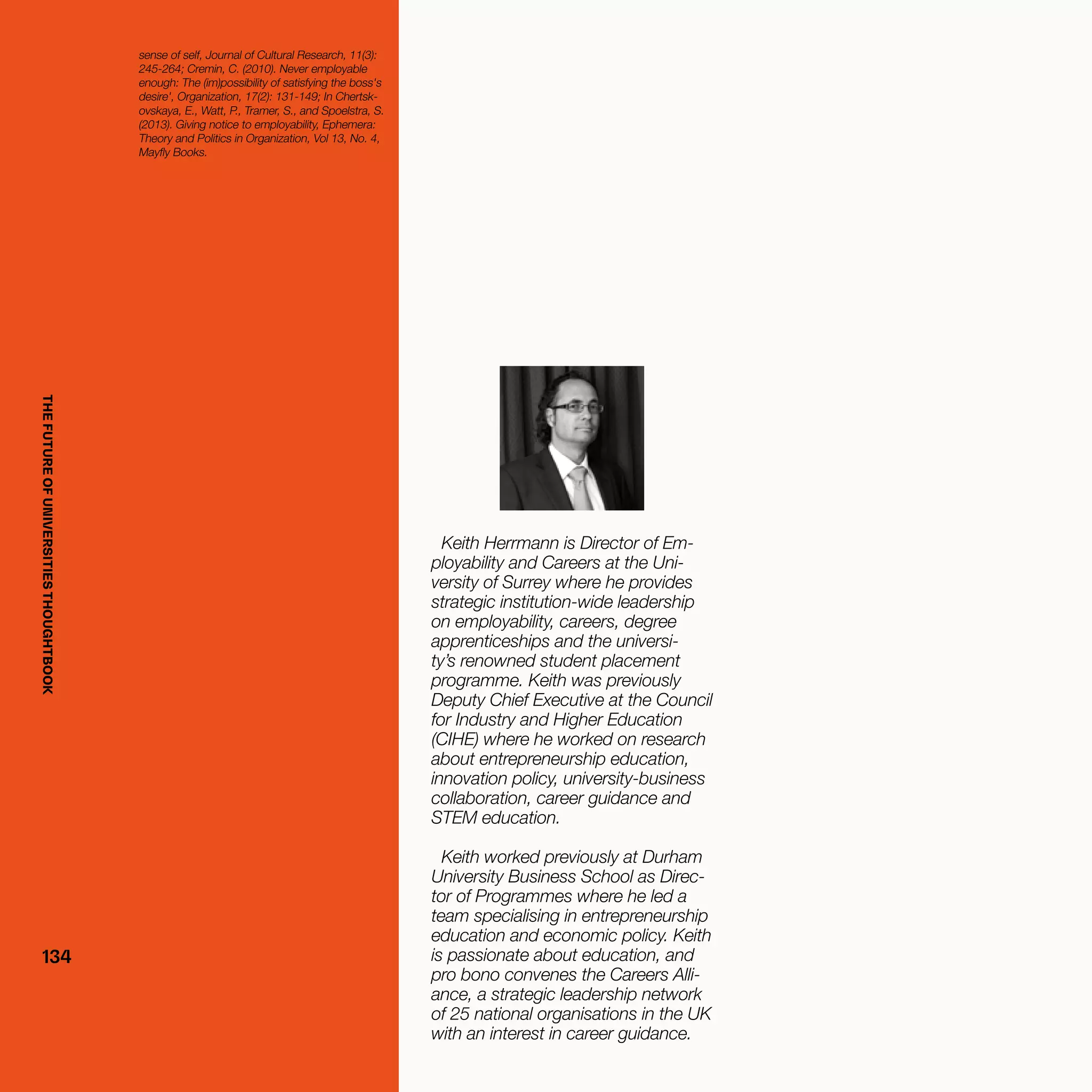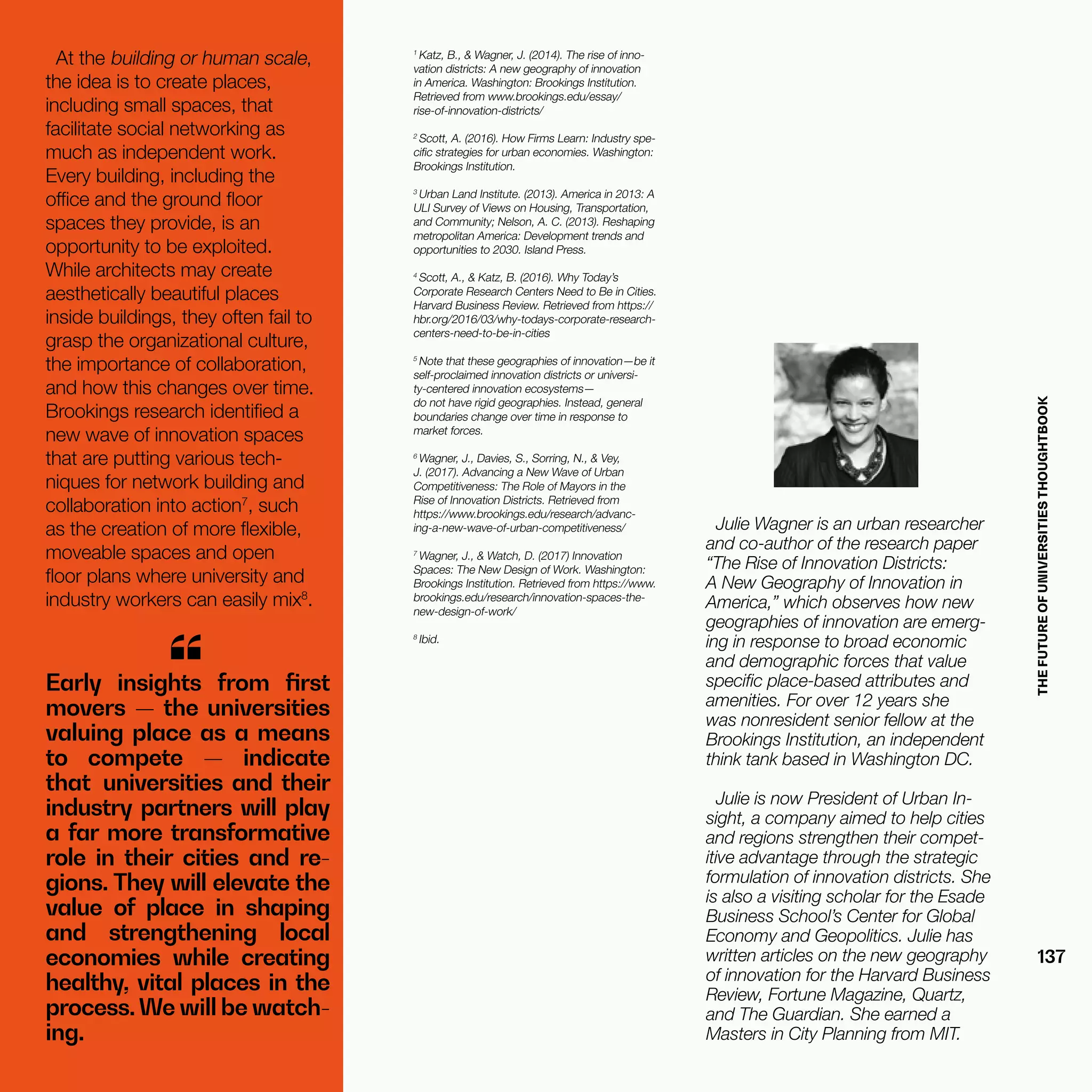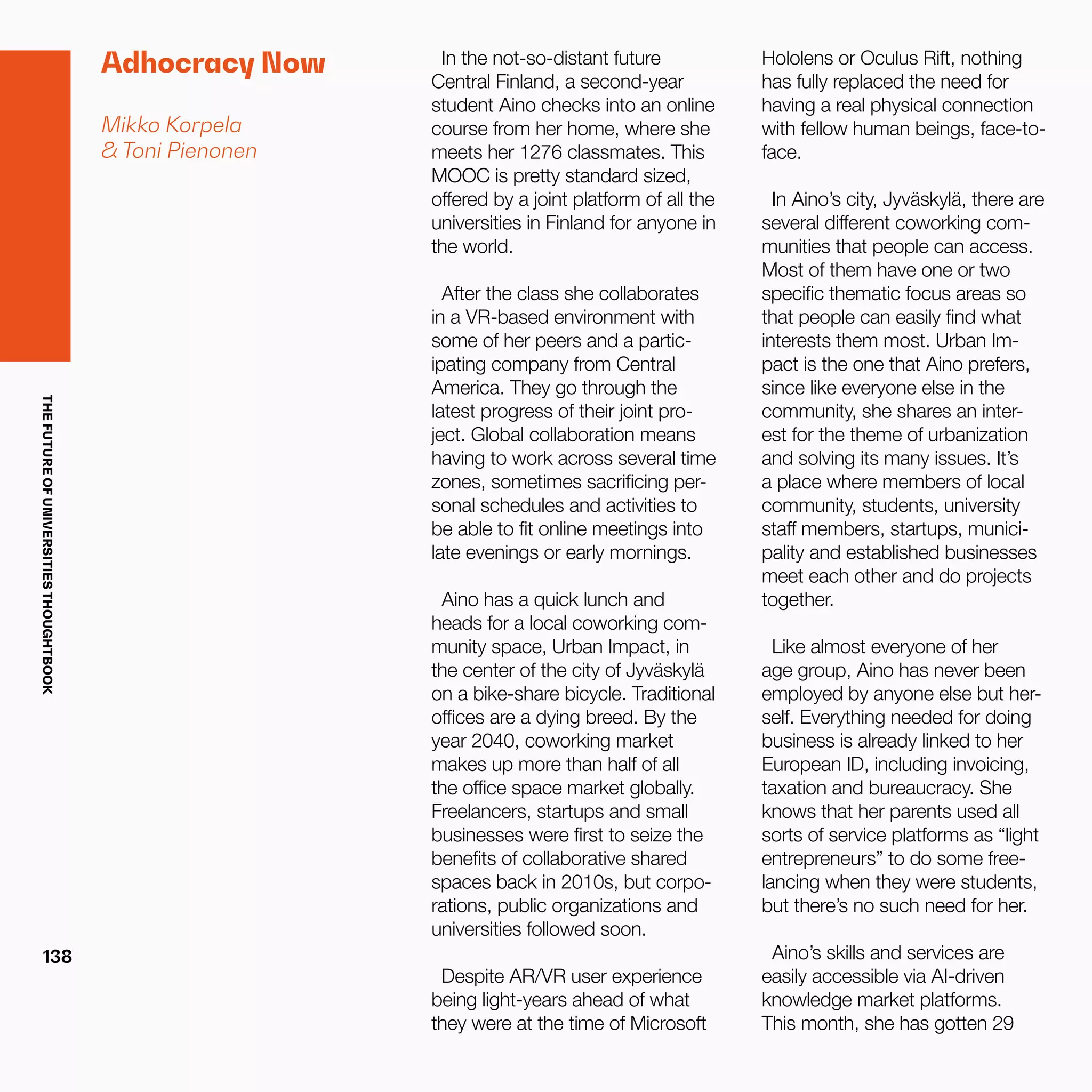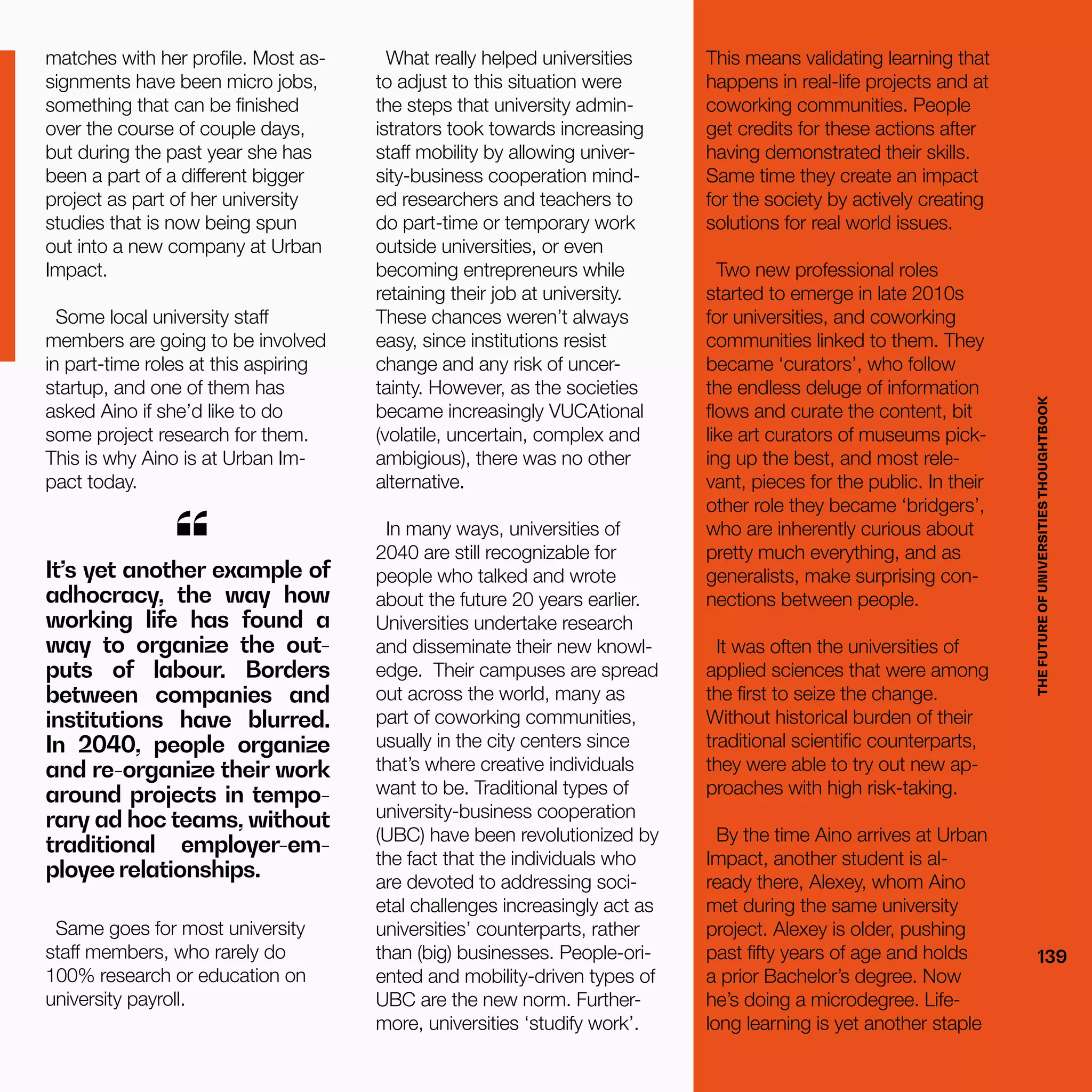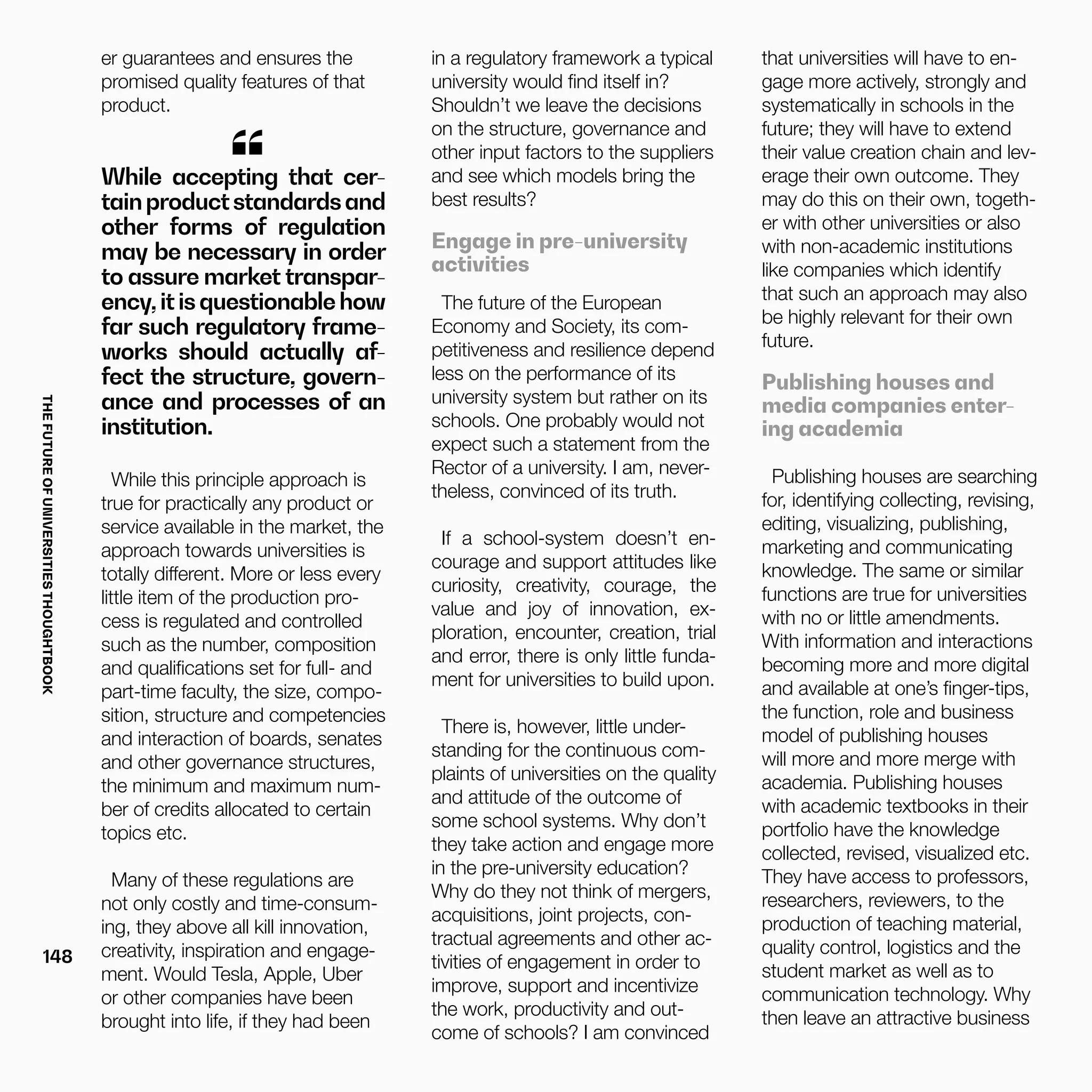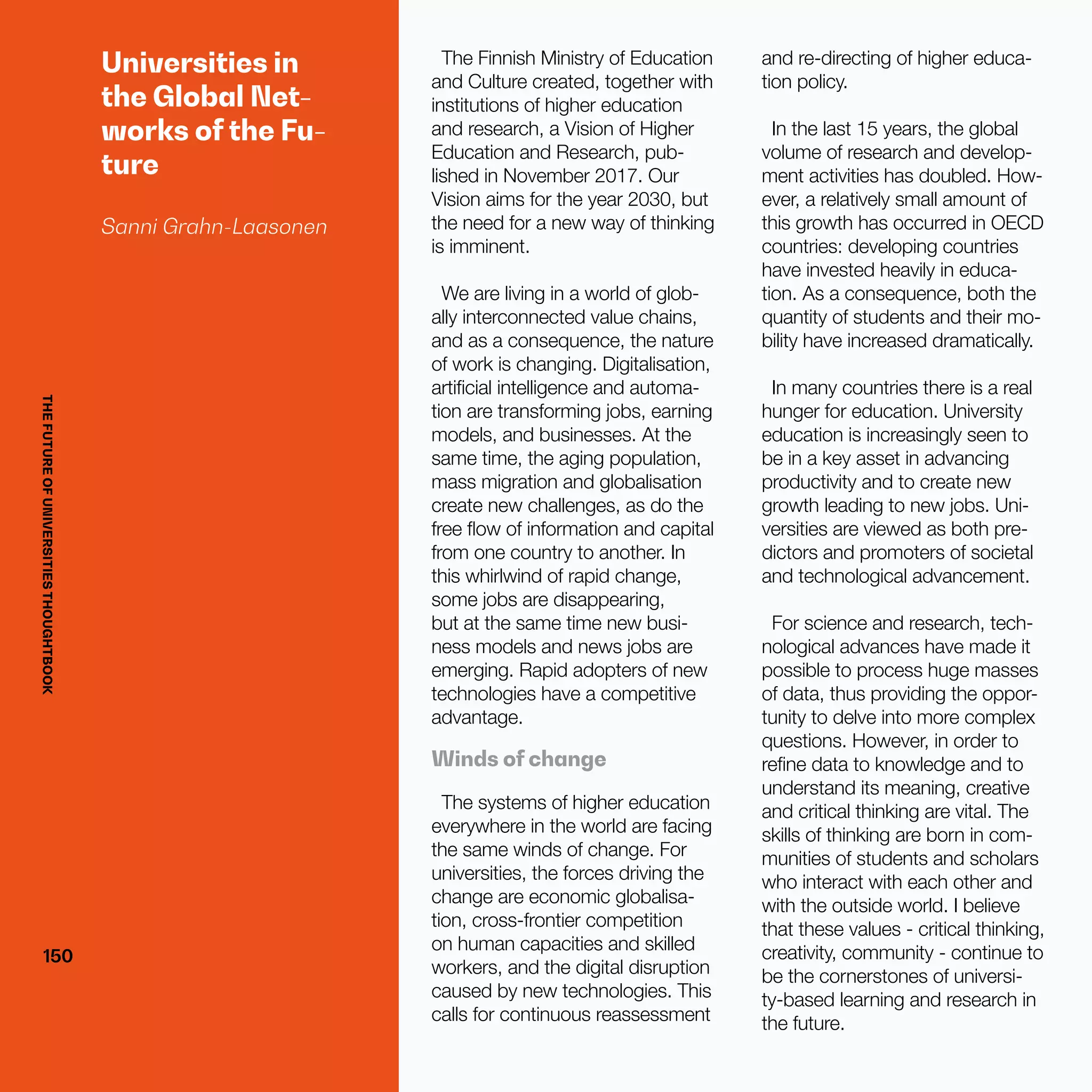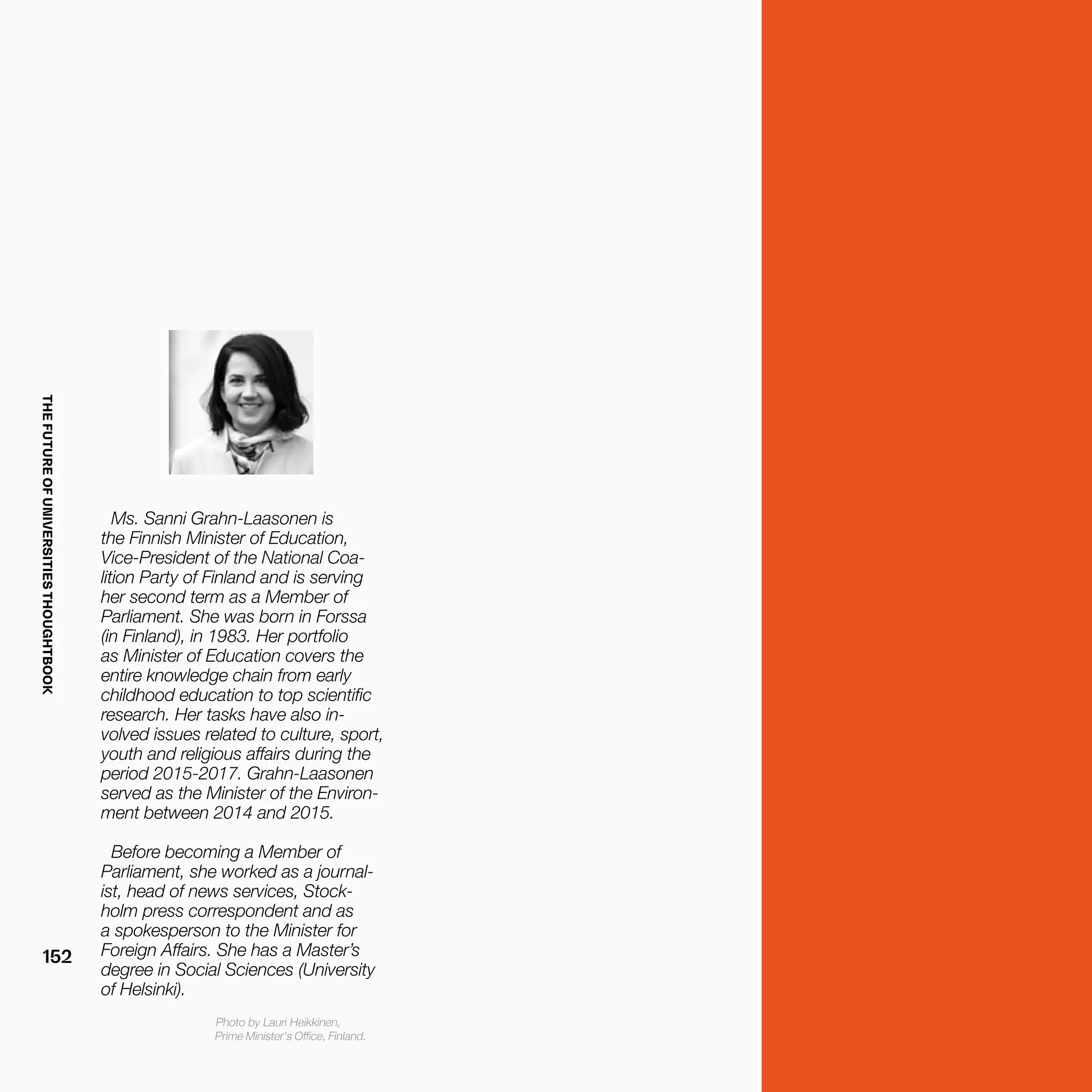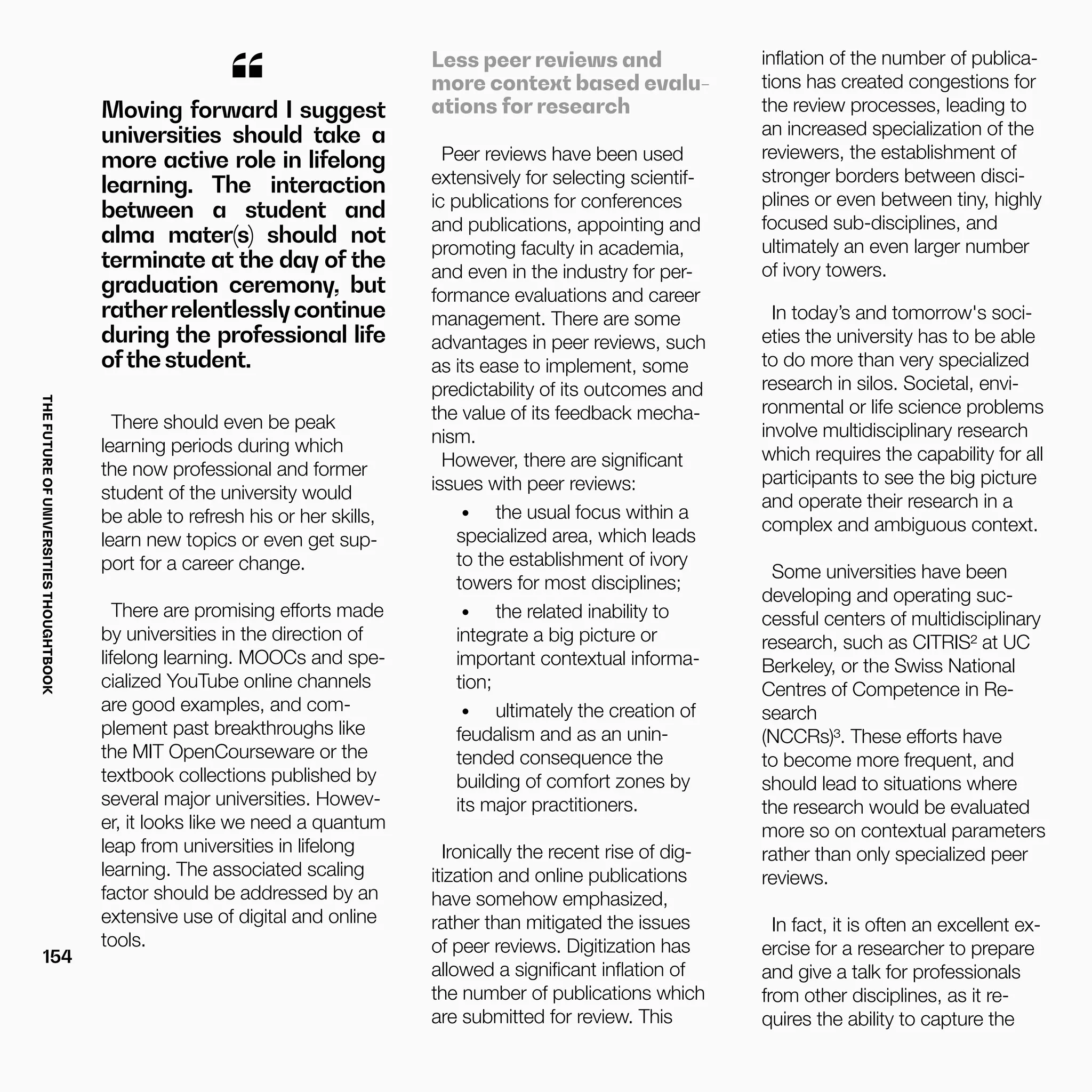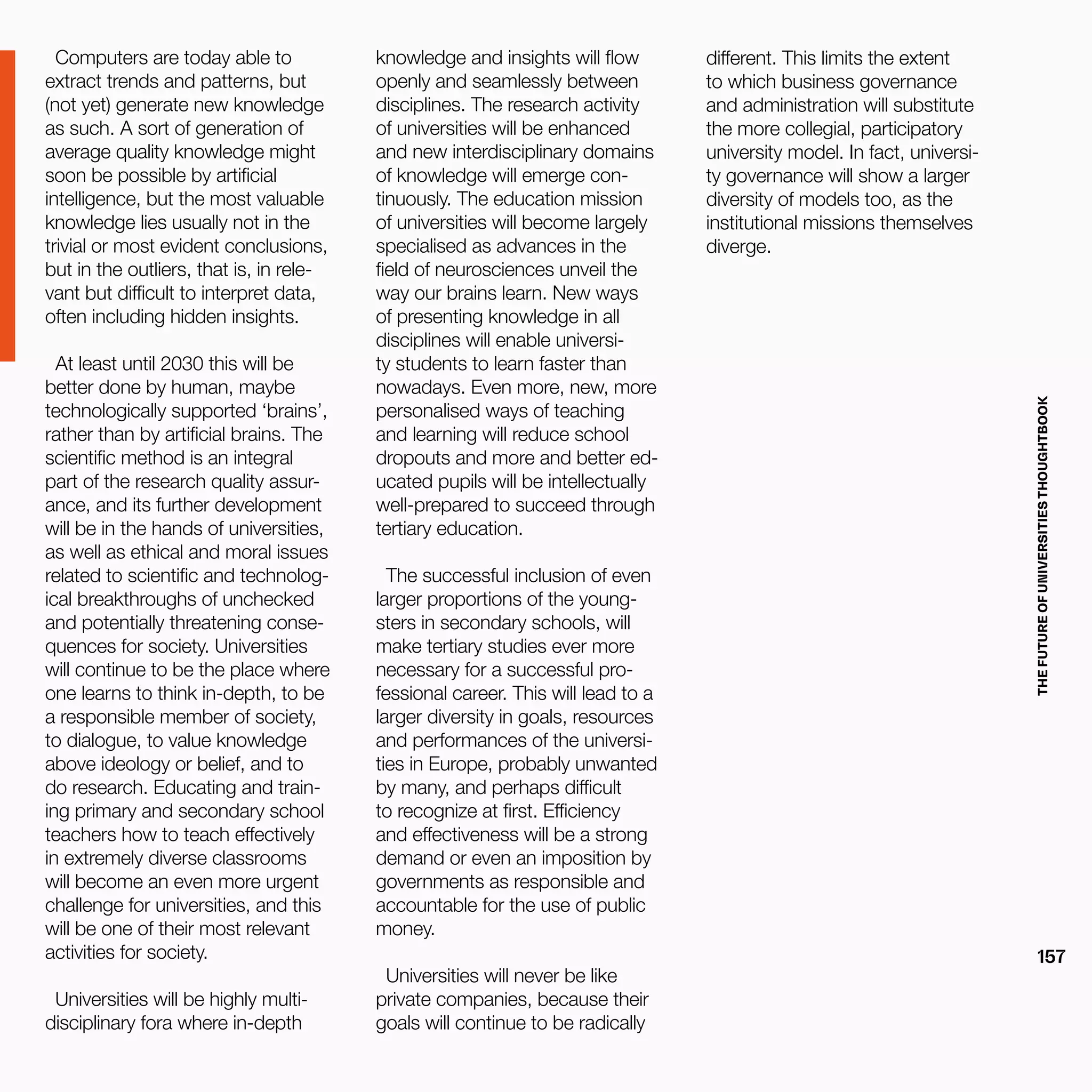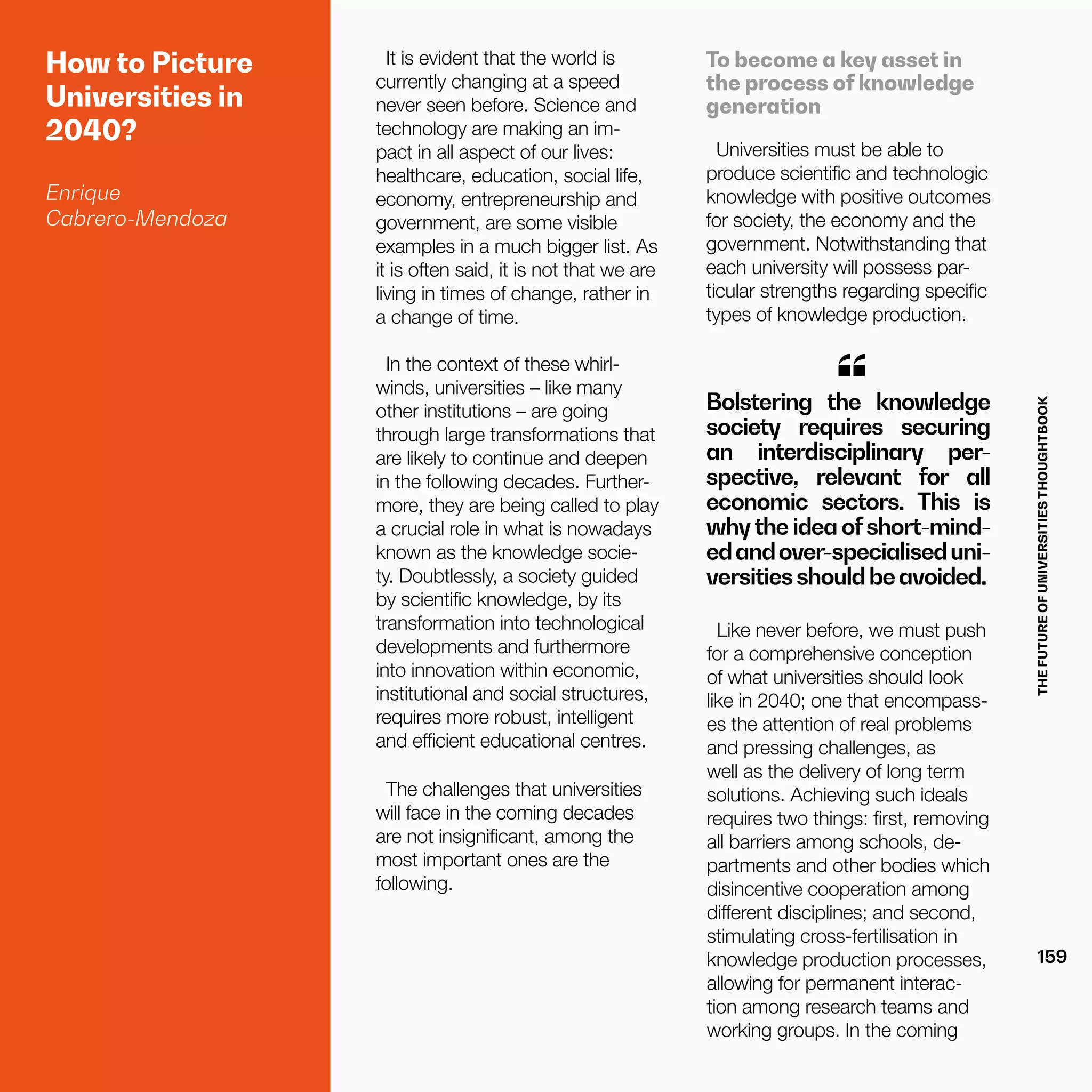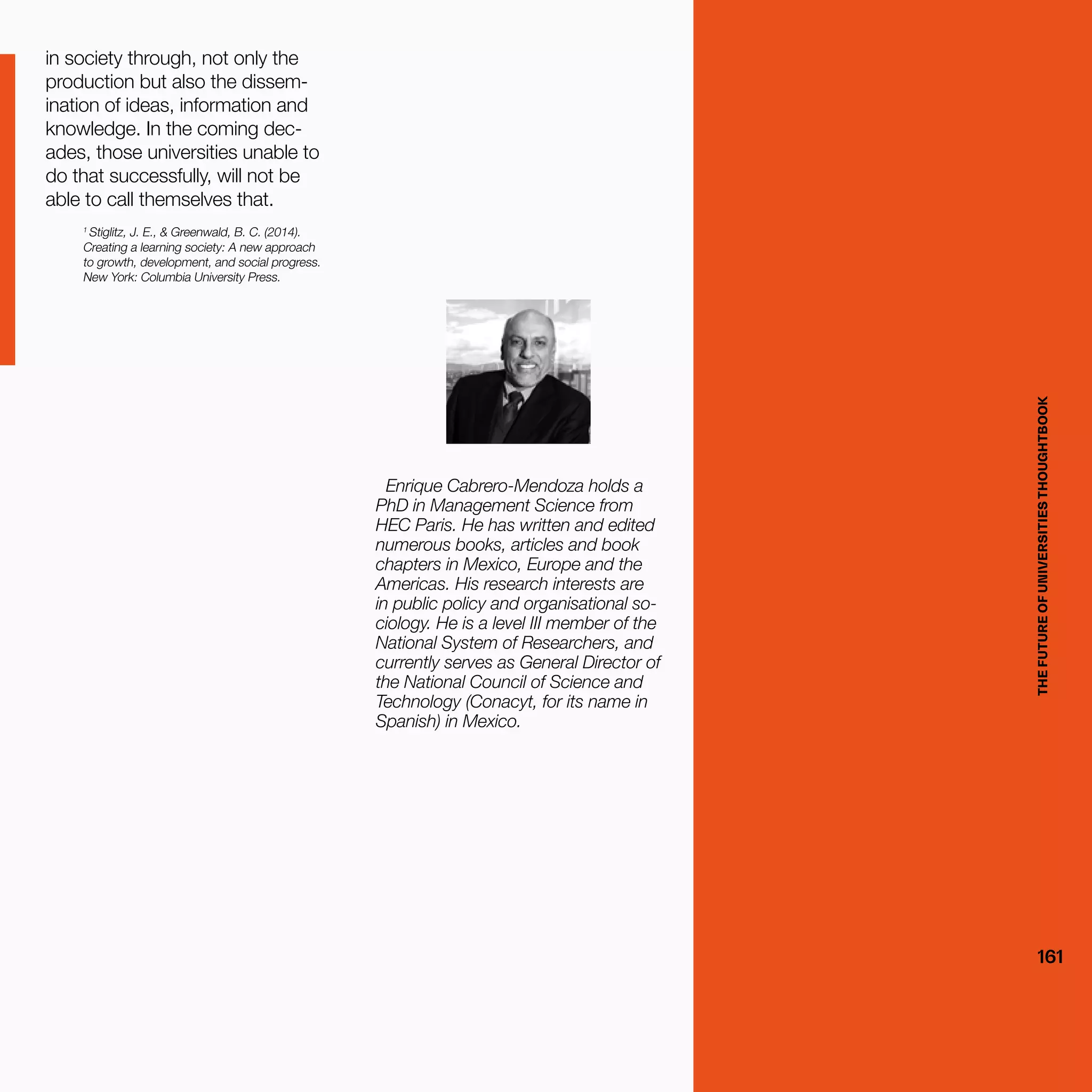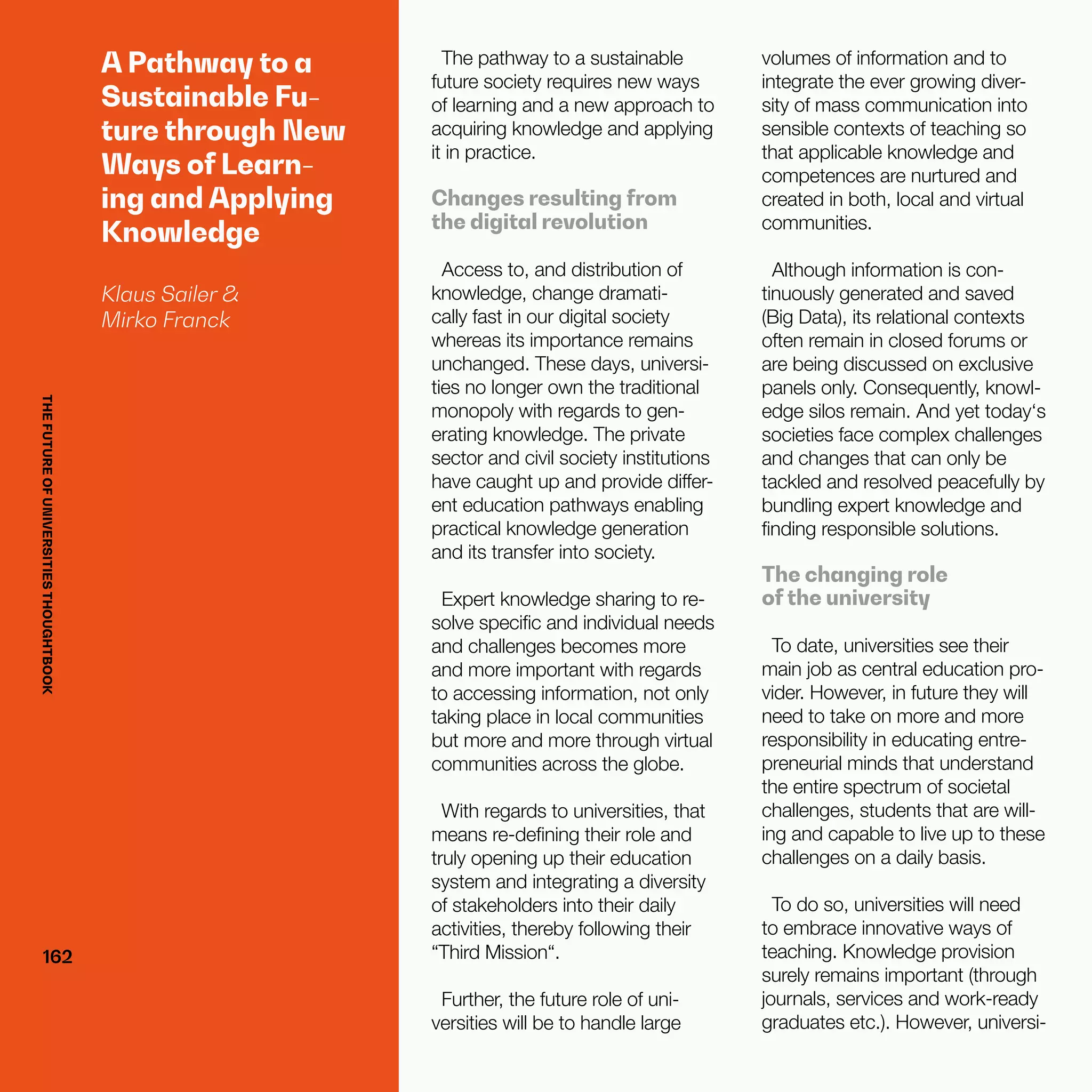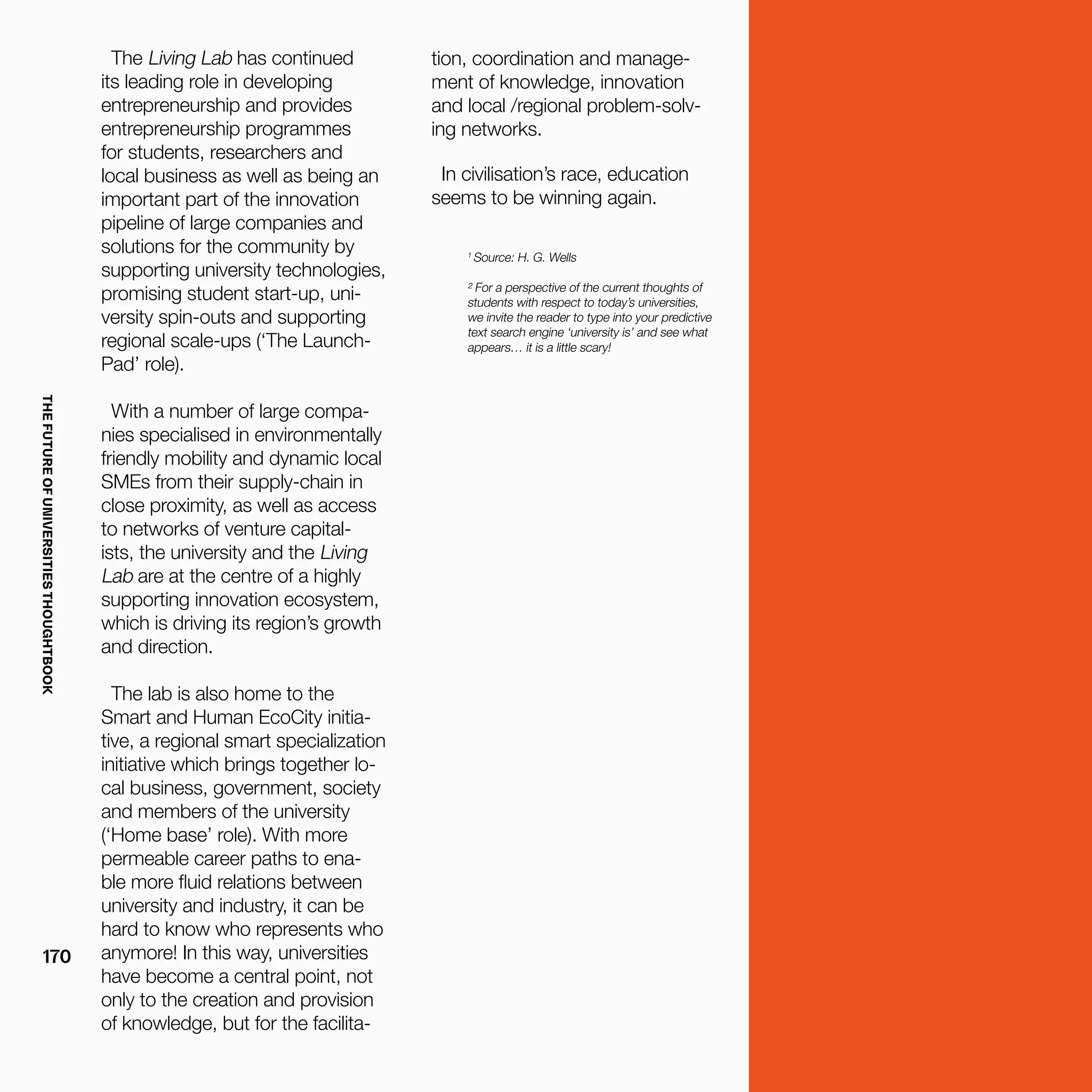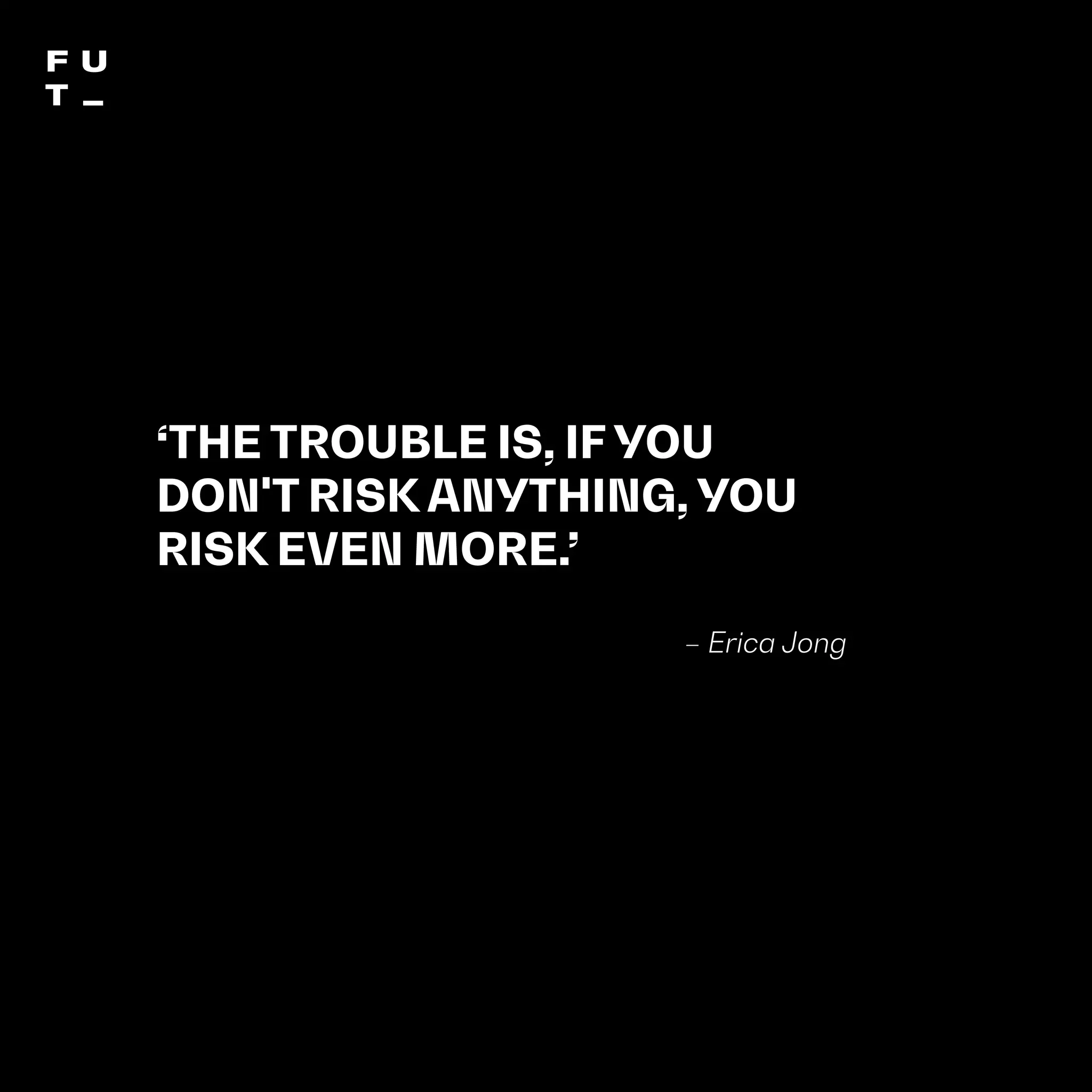This document provides an introduction to the future of universities by examining how four global megatrends identified by McKinsey may impact universities until 2040. The megatrends are: emerging markets and urbanization, greater global connections, accelerating technological change, and responding to an aging world. Emerging markets and urbanization are expected to shift economic scales towards Asia and increase global demand for higher education, benefiting local universities in emerging countries and elite universities elsewhere. Greater connectivity and technology will require universities to offer more flexible, online, and lifelong learning opportunities. An aging population will drive demand for retraining and skills development throughout people's careers.




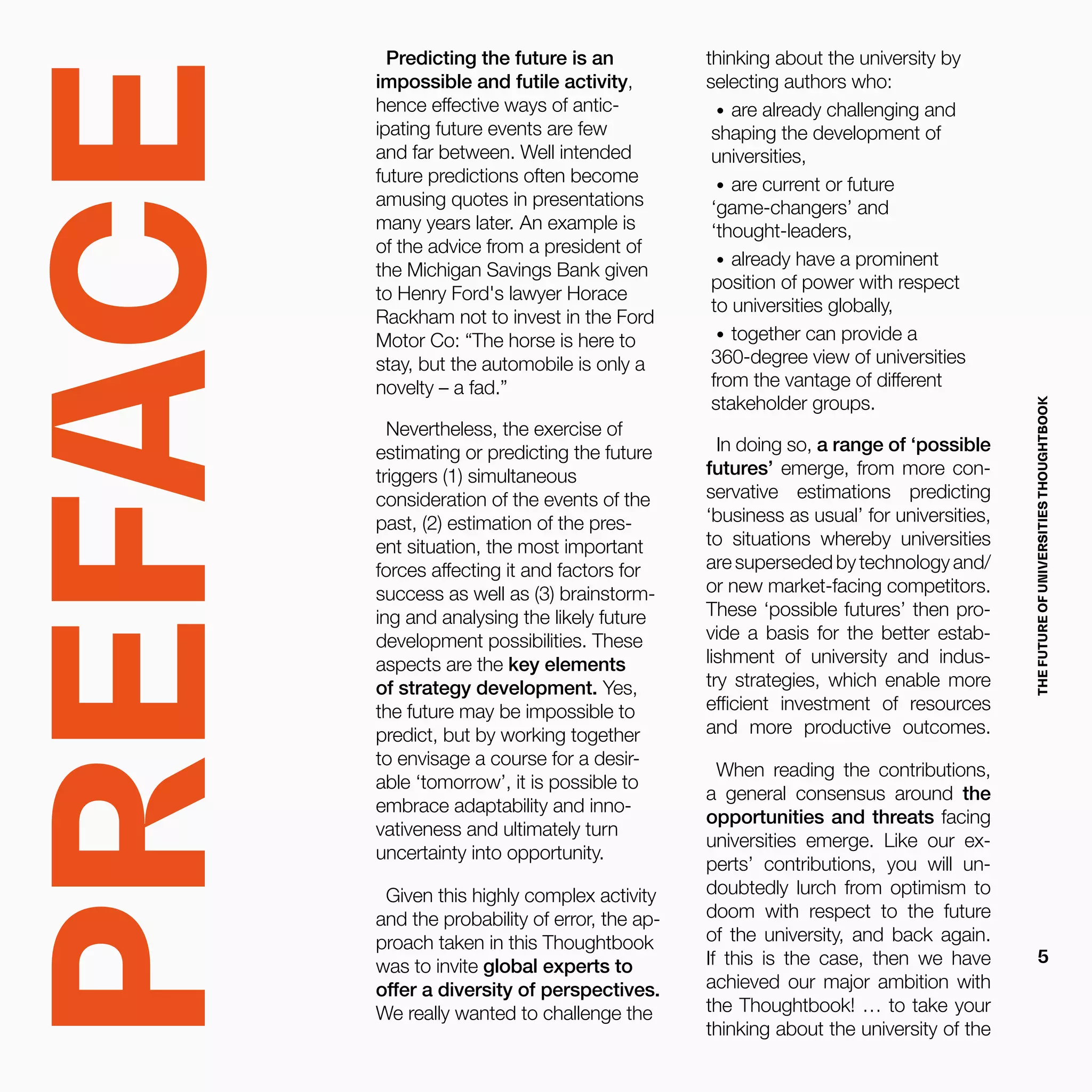
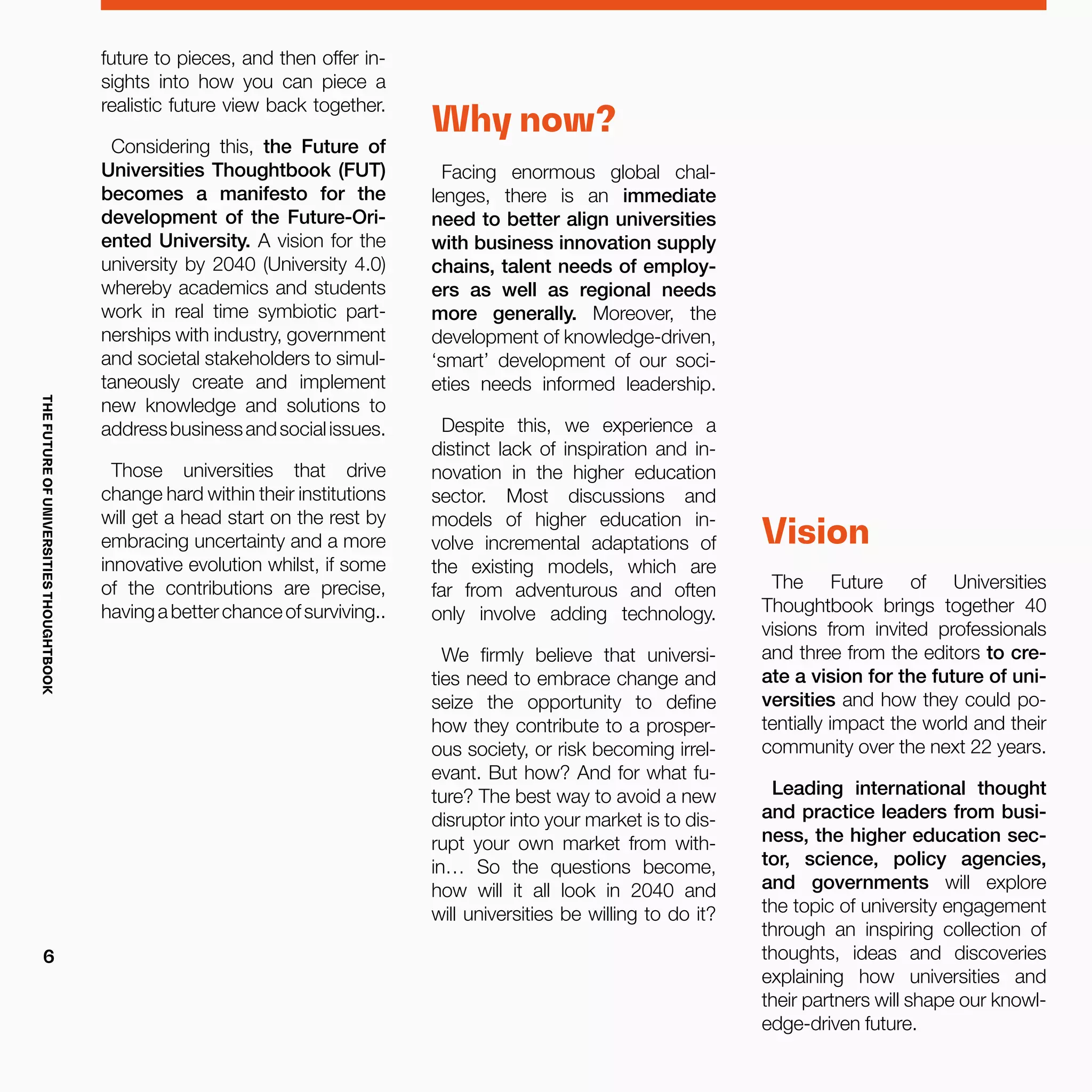


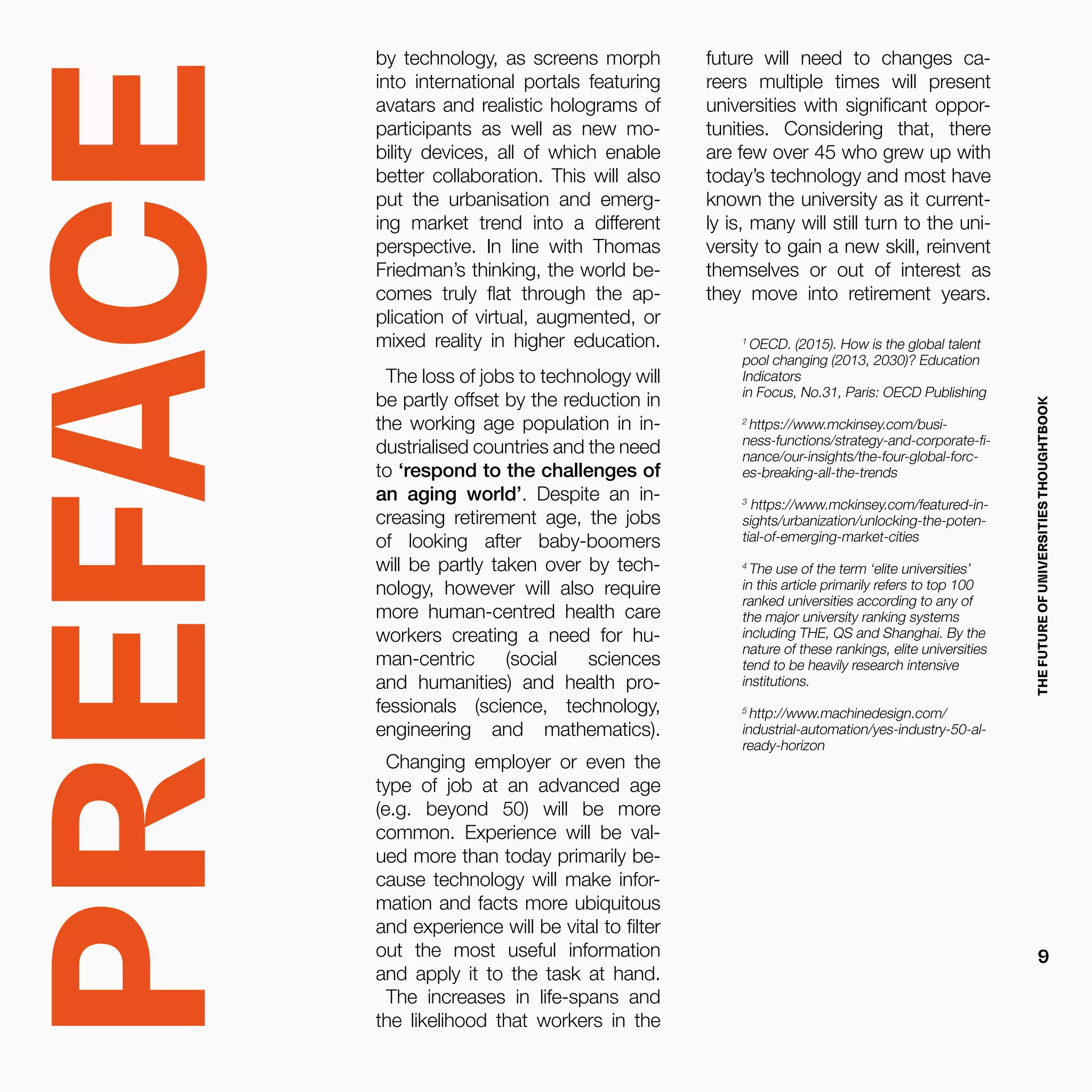


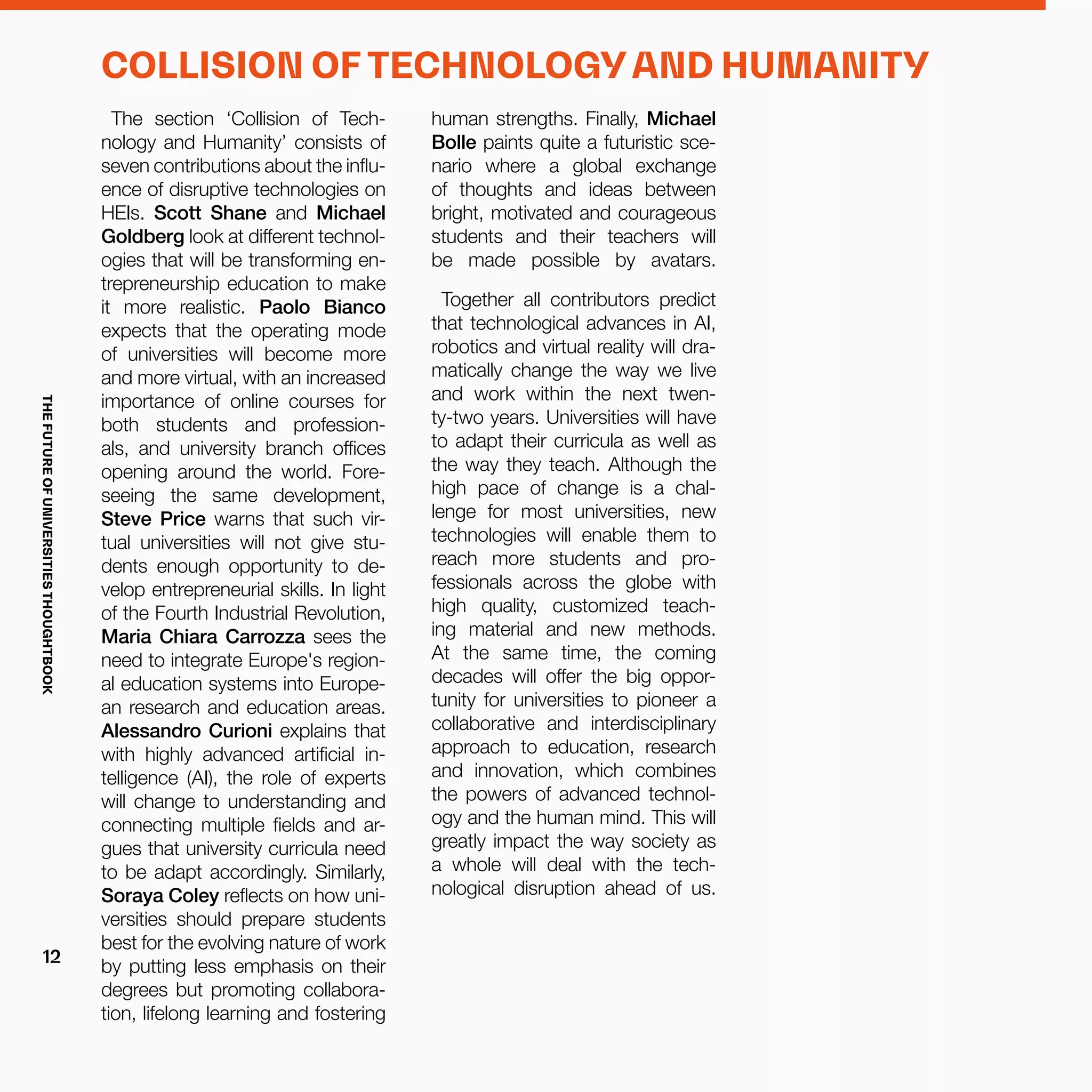
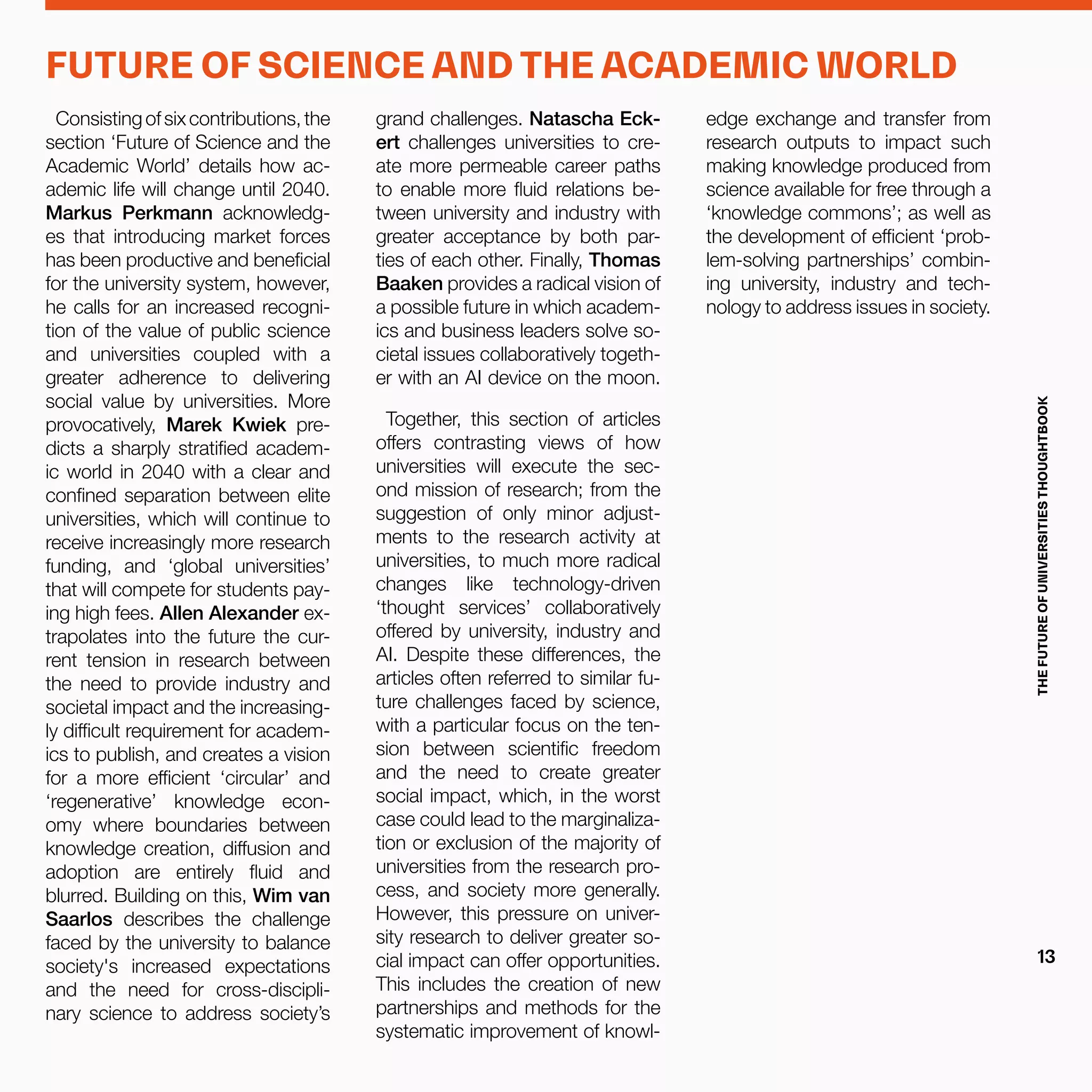
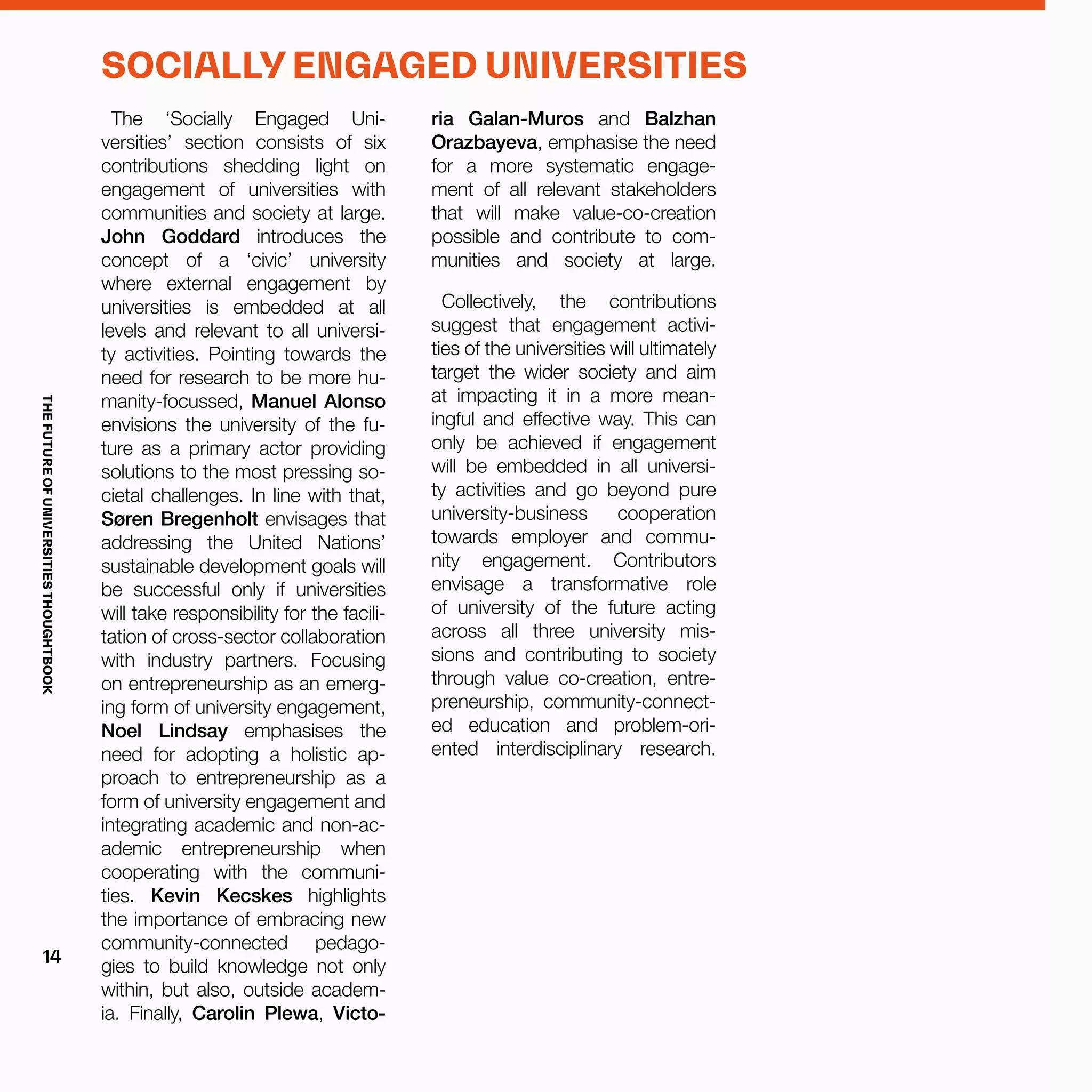

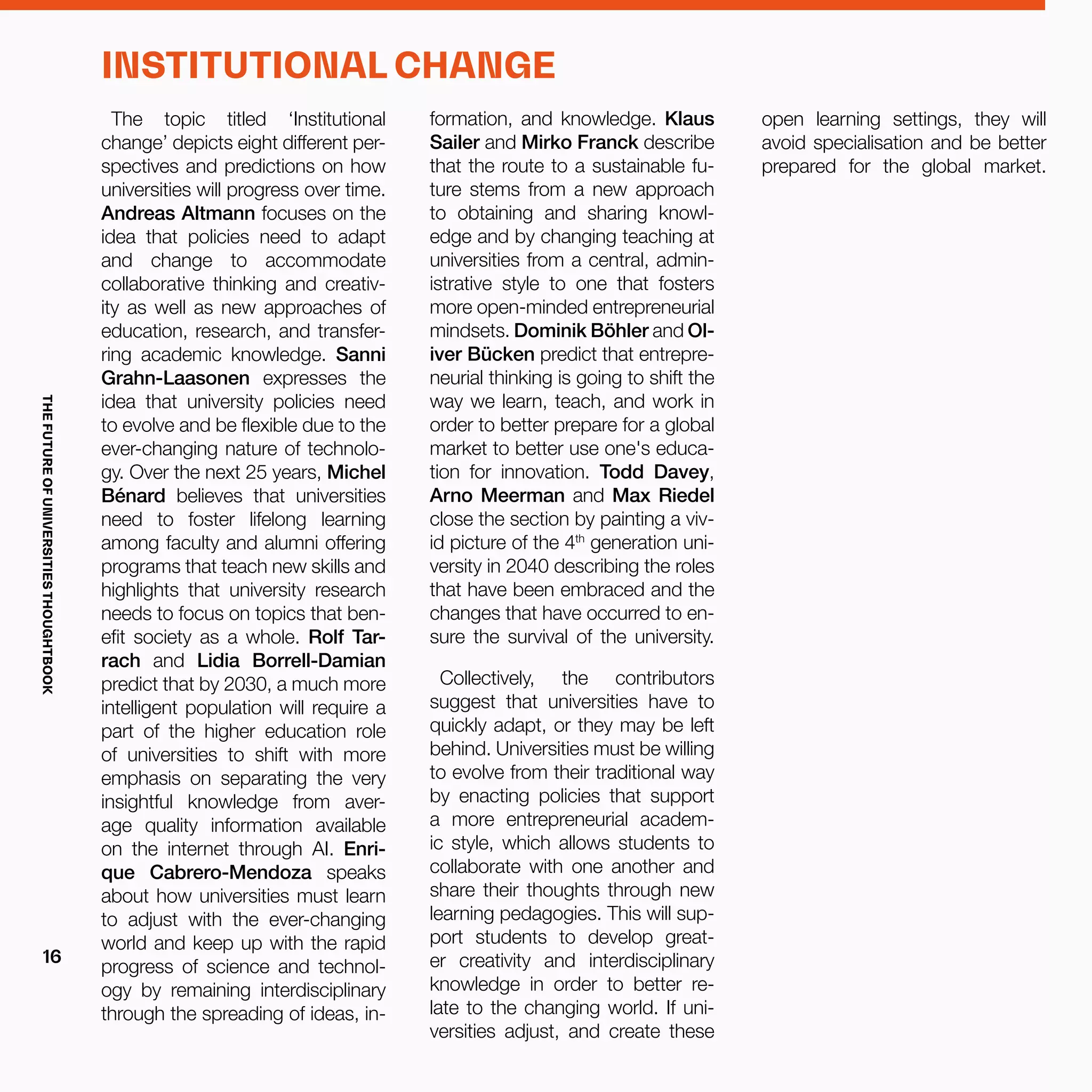
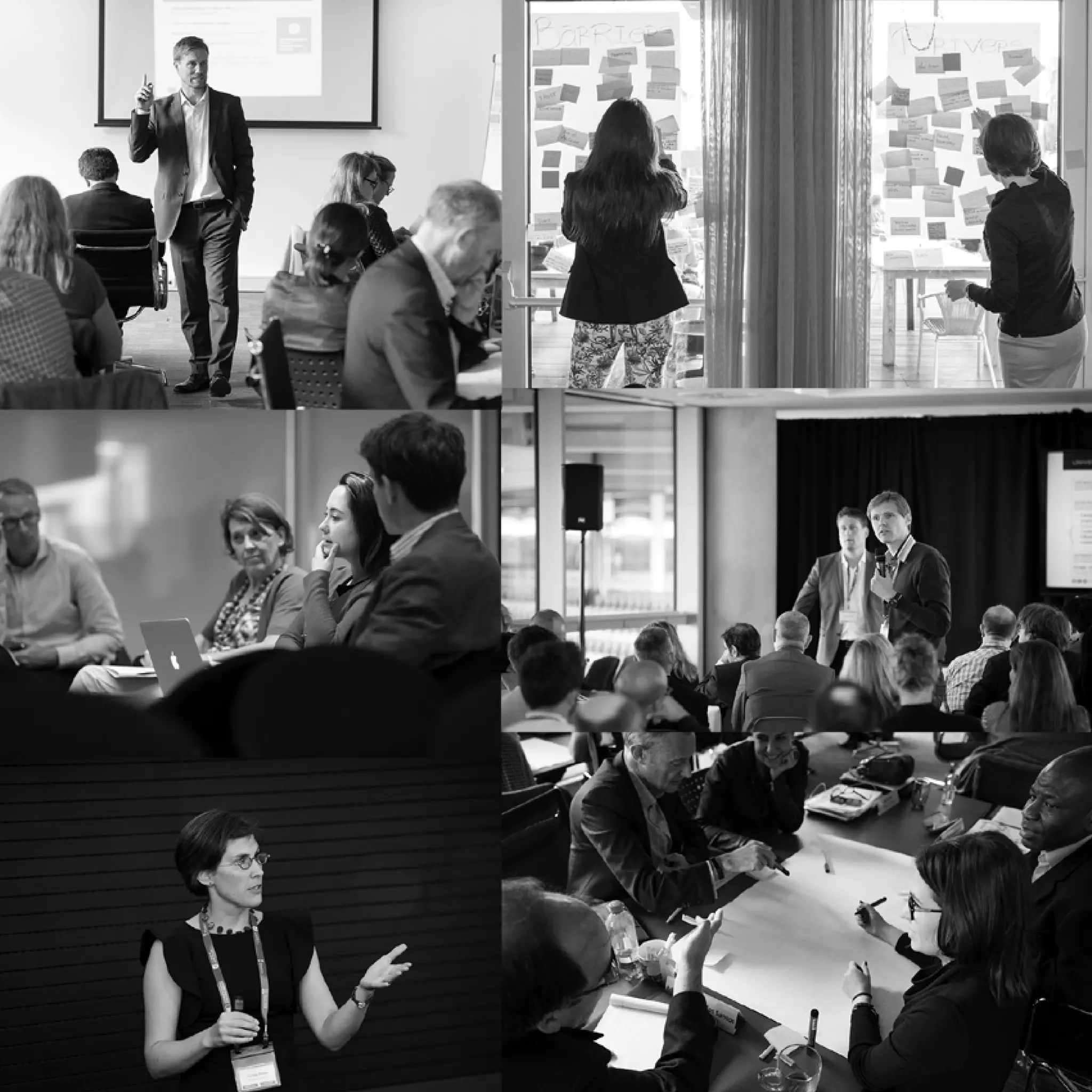











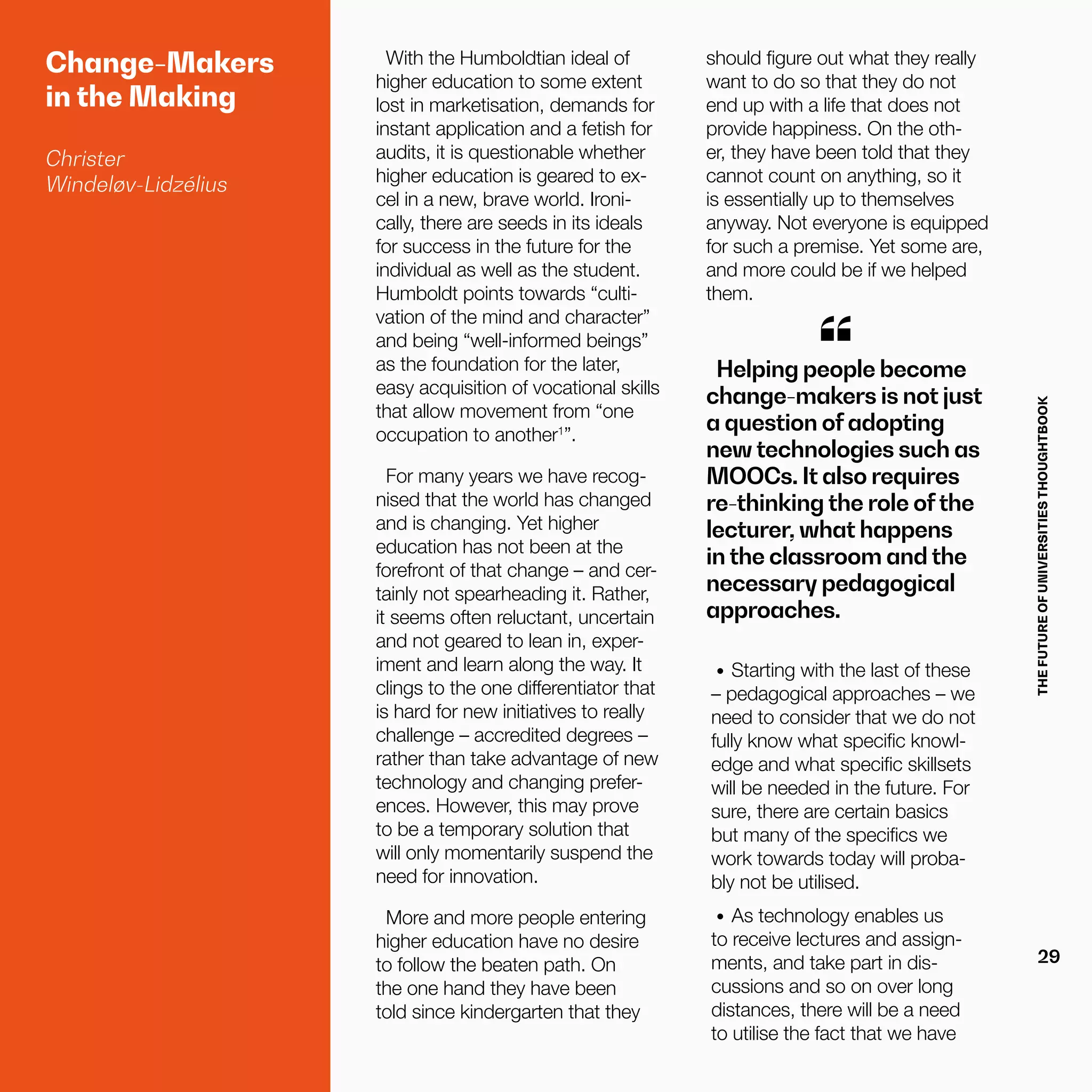
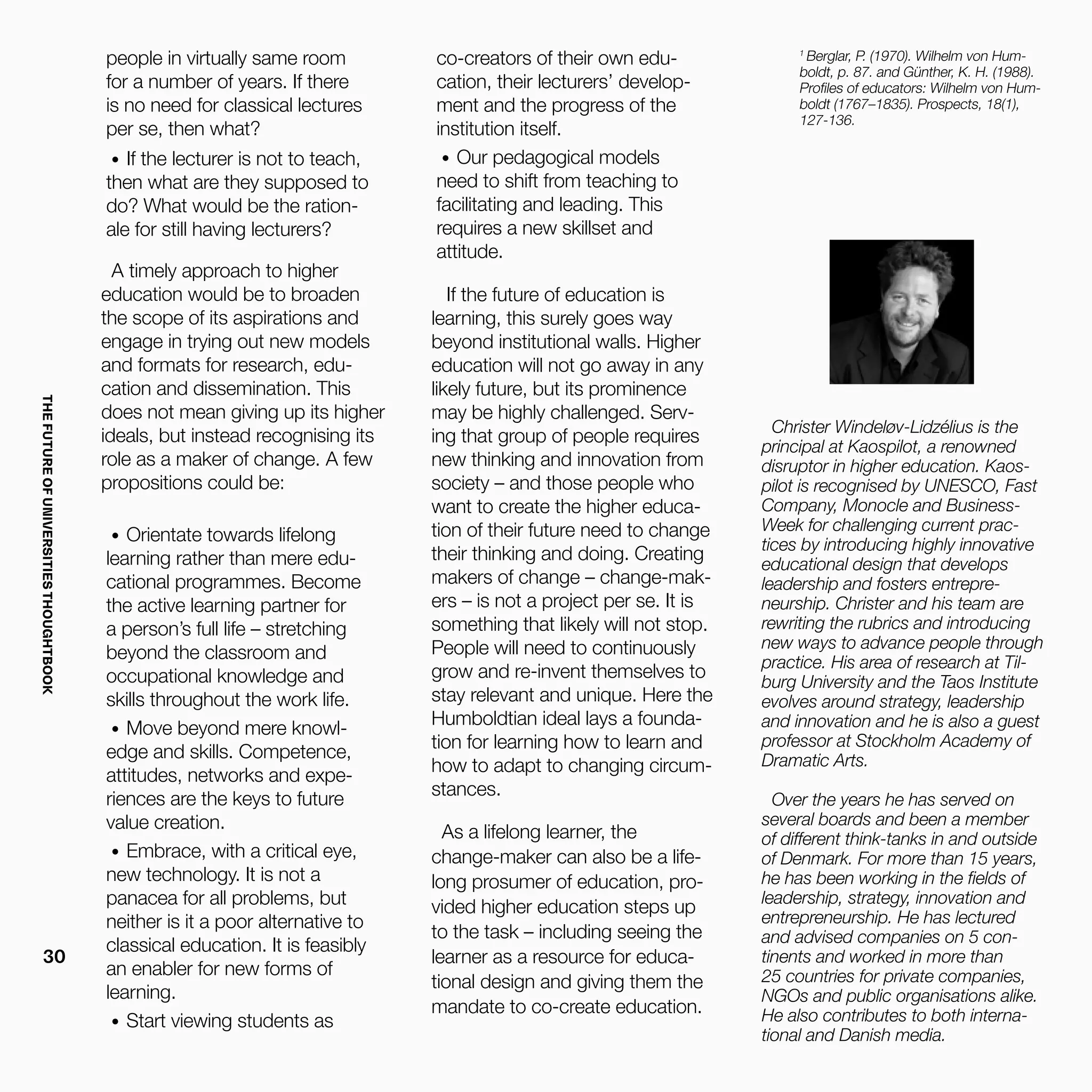
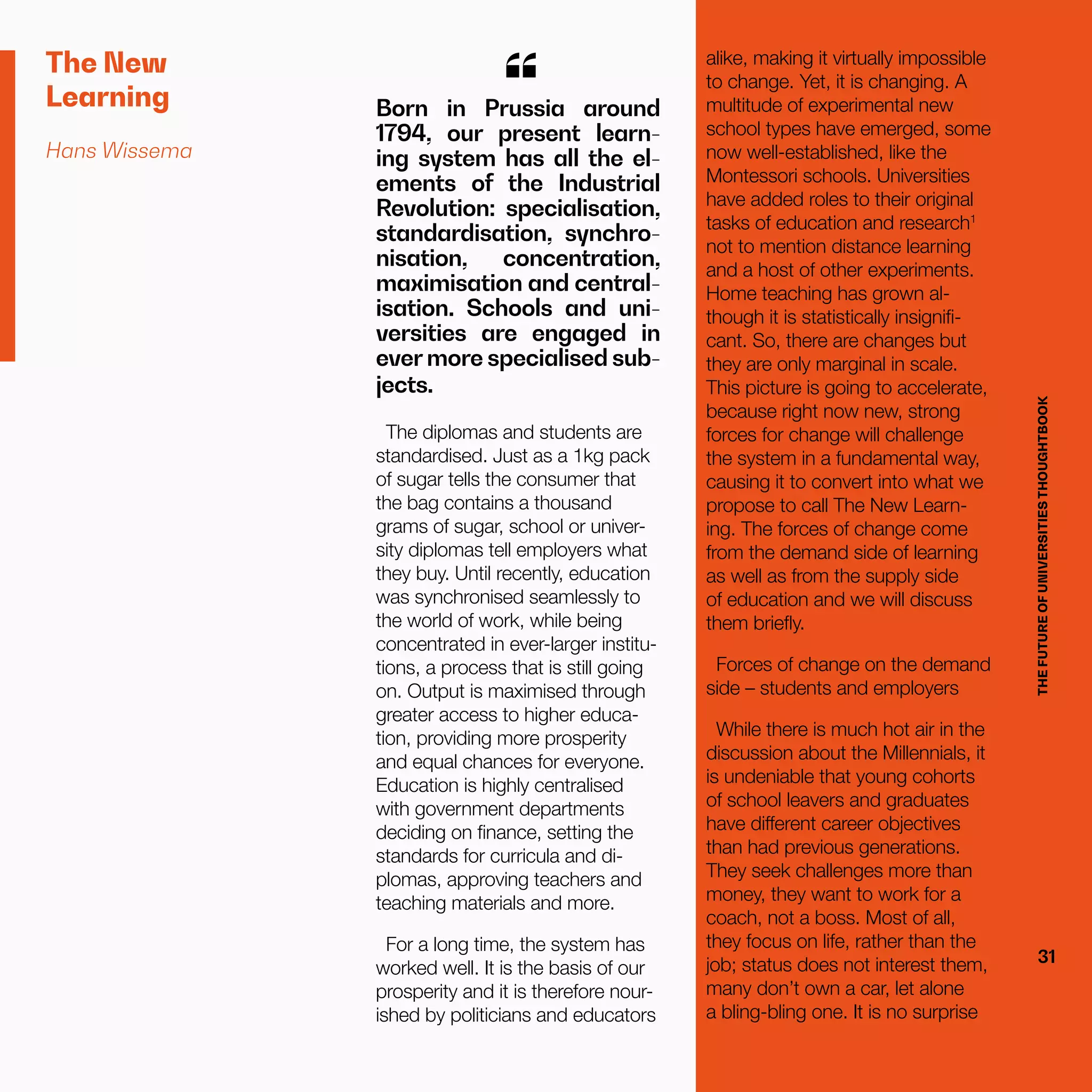
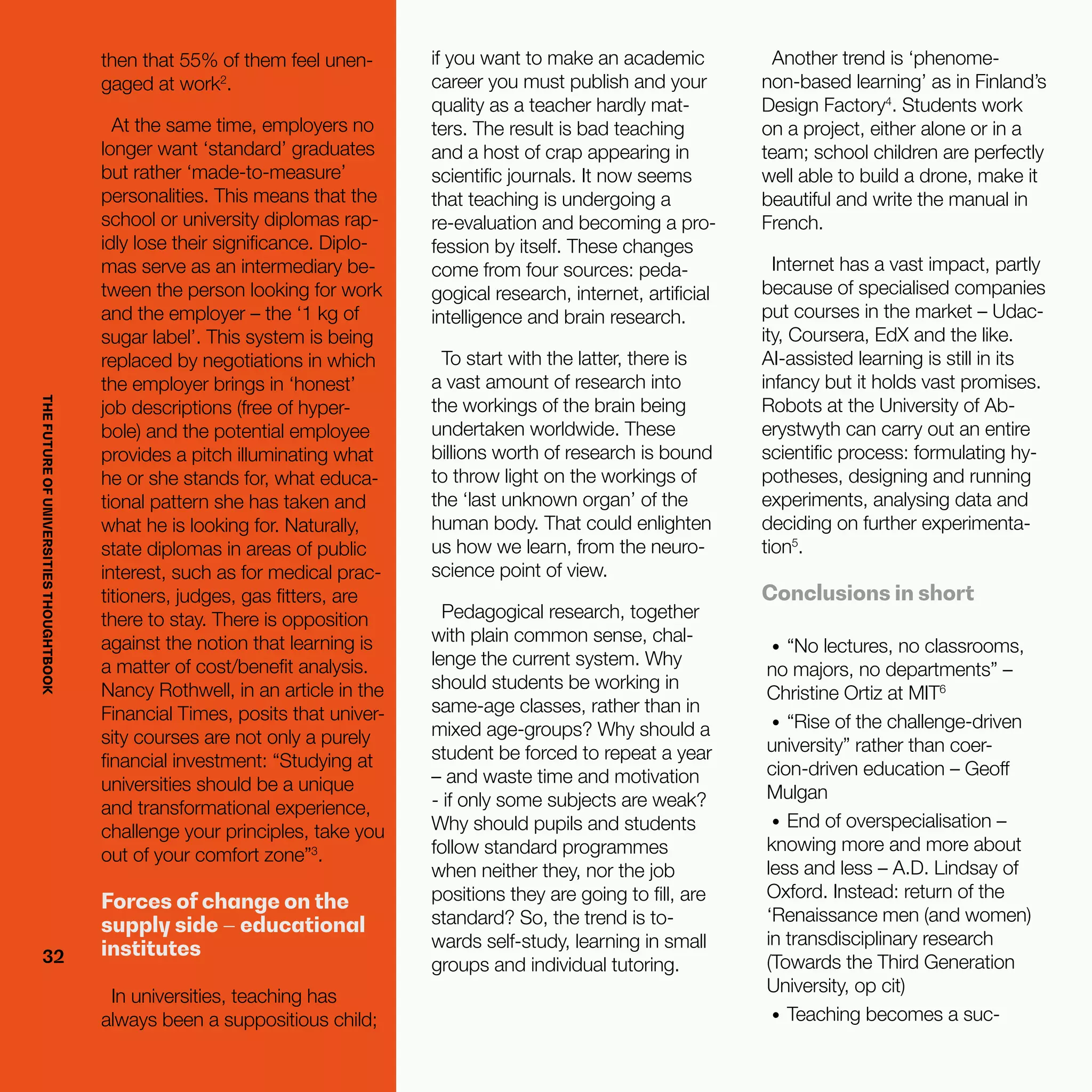
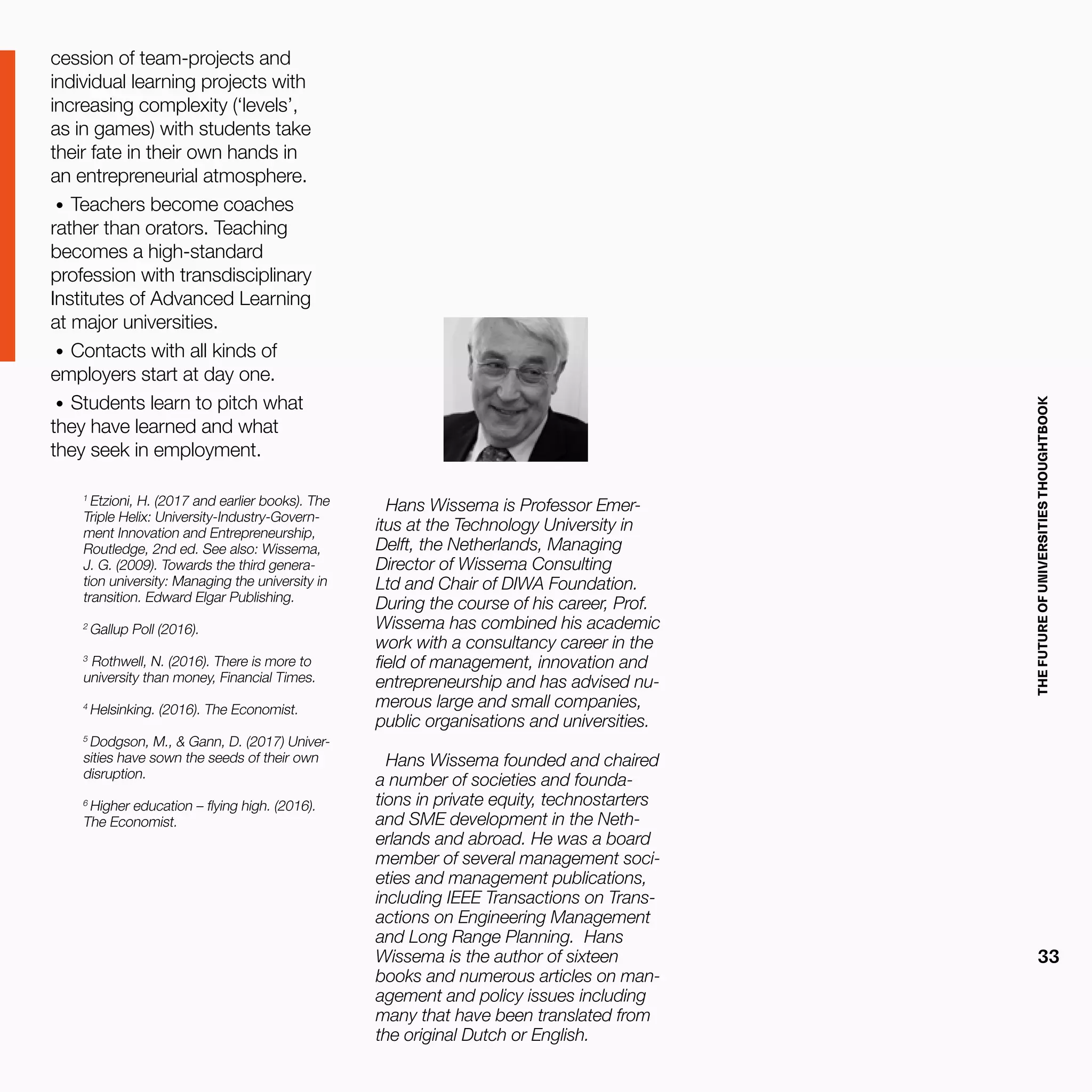

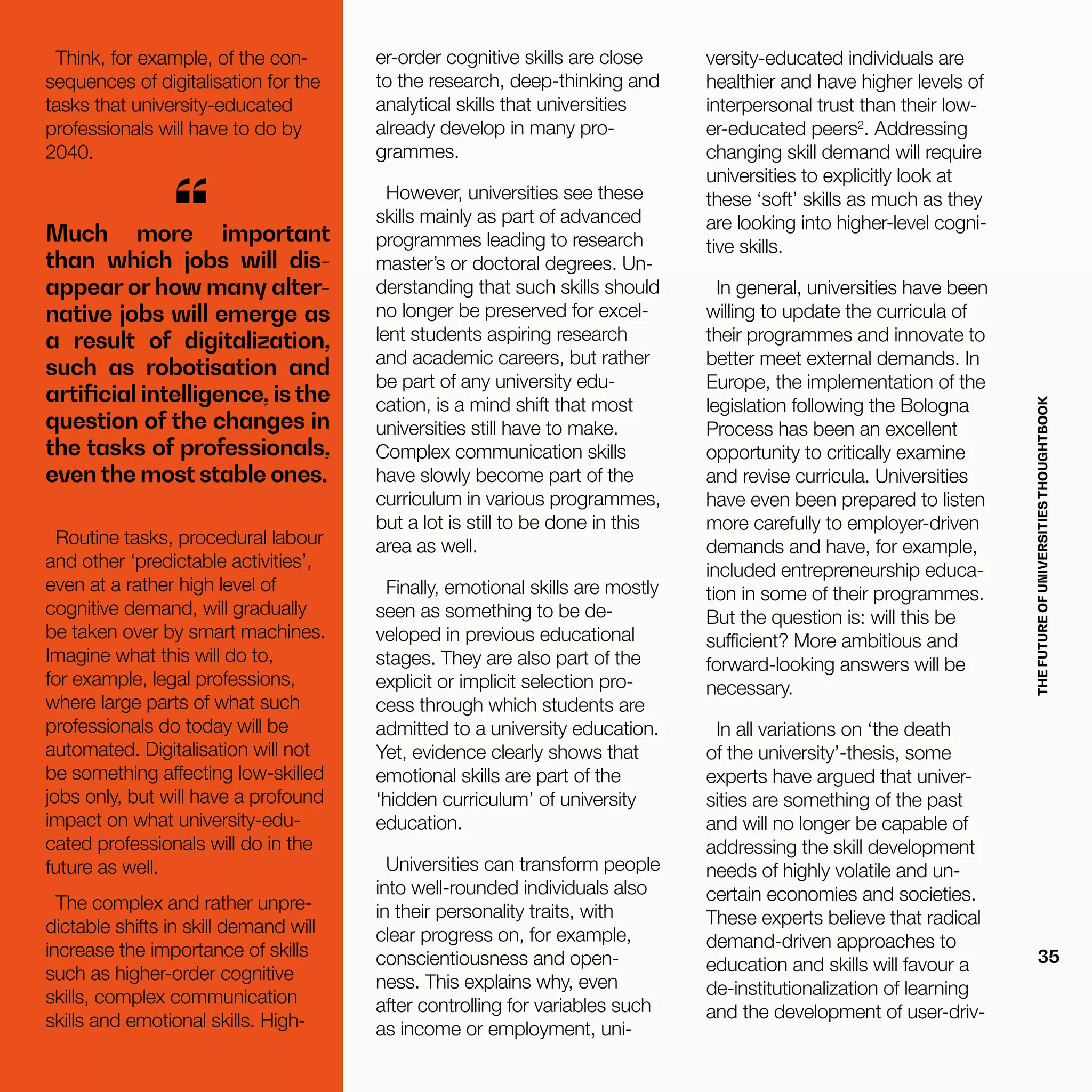

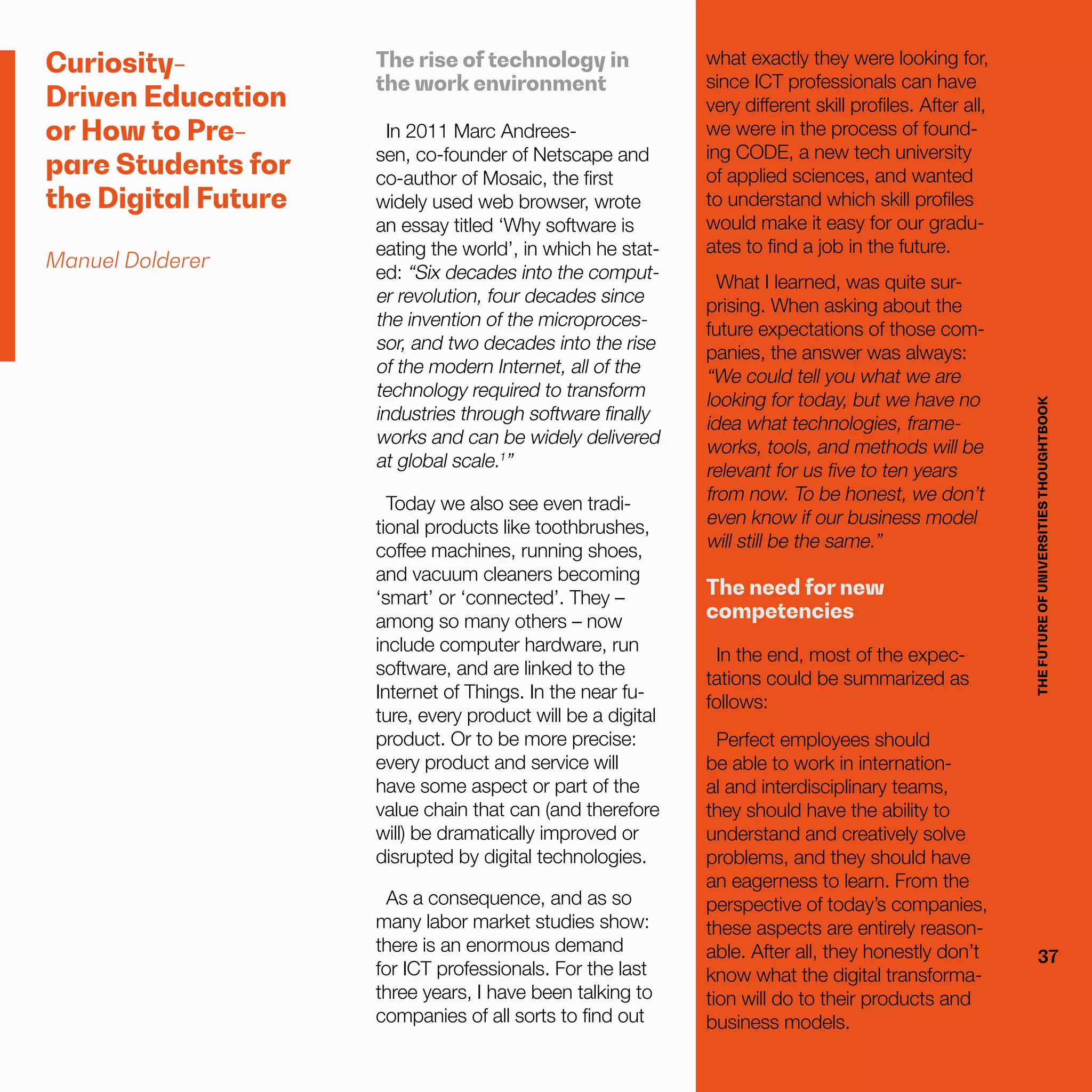



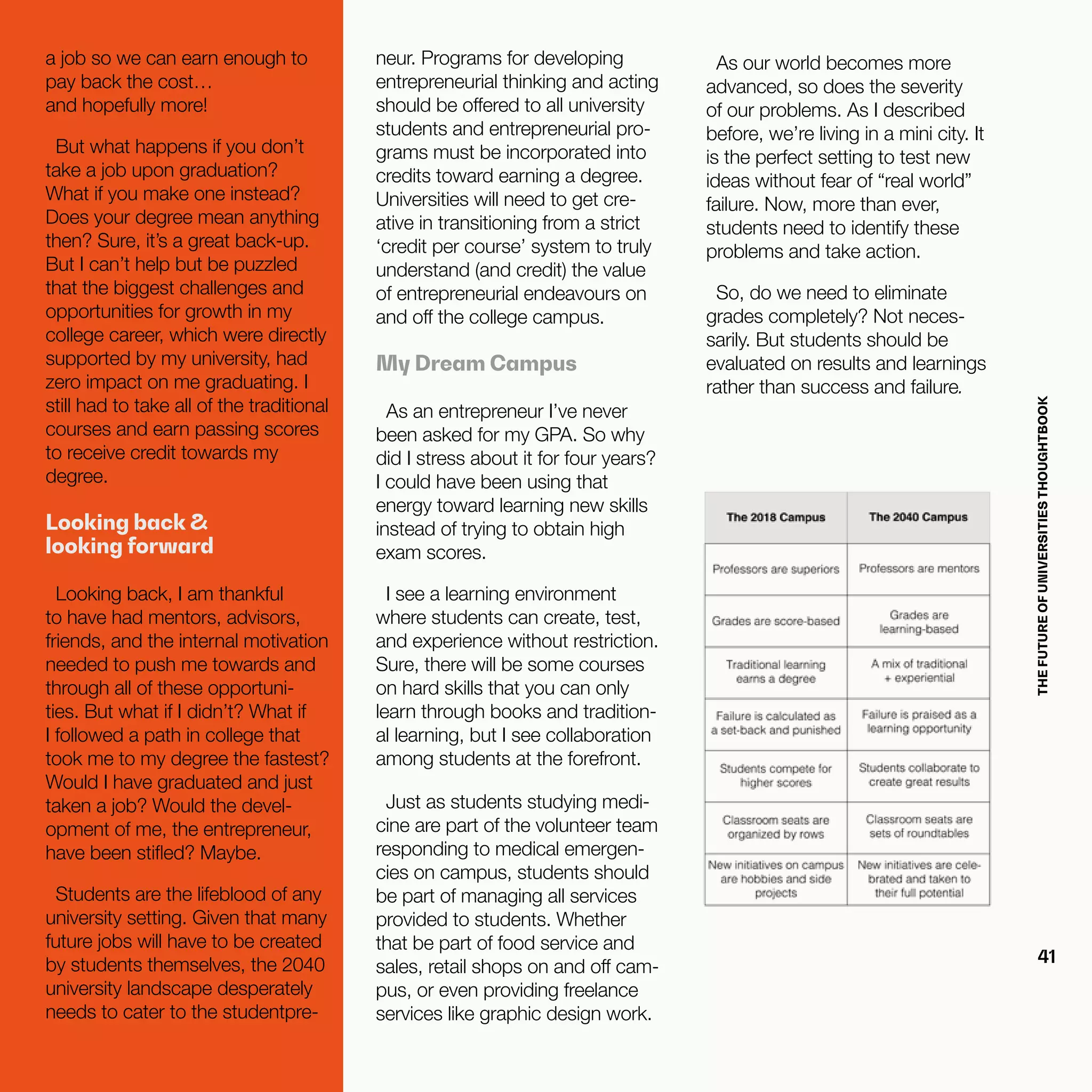
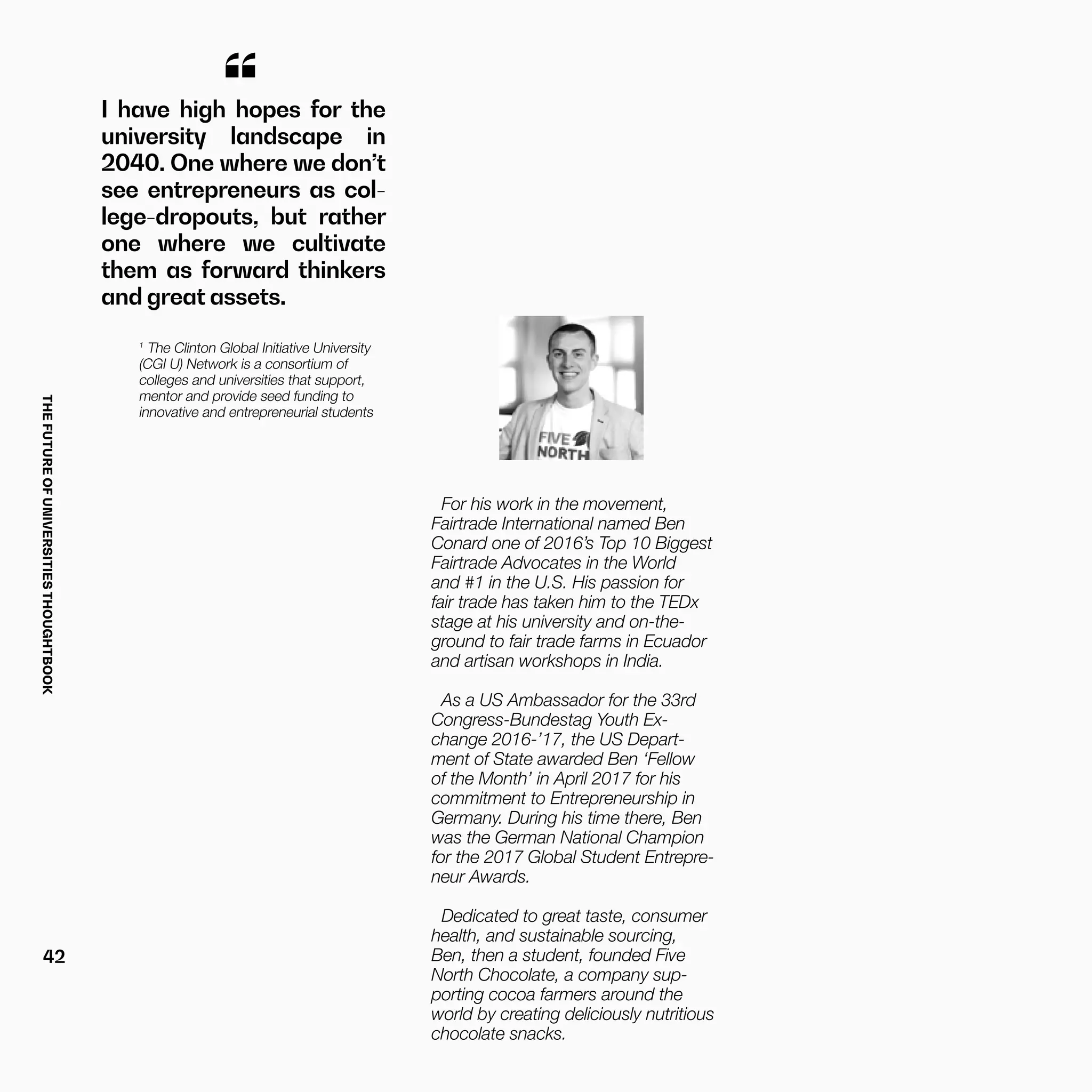








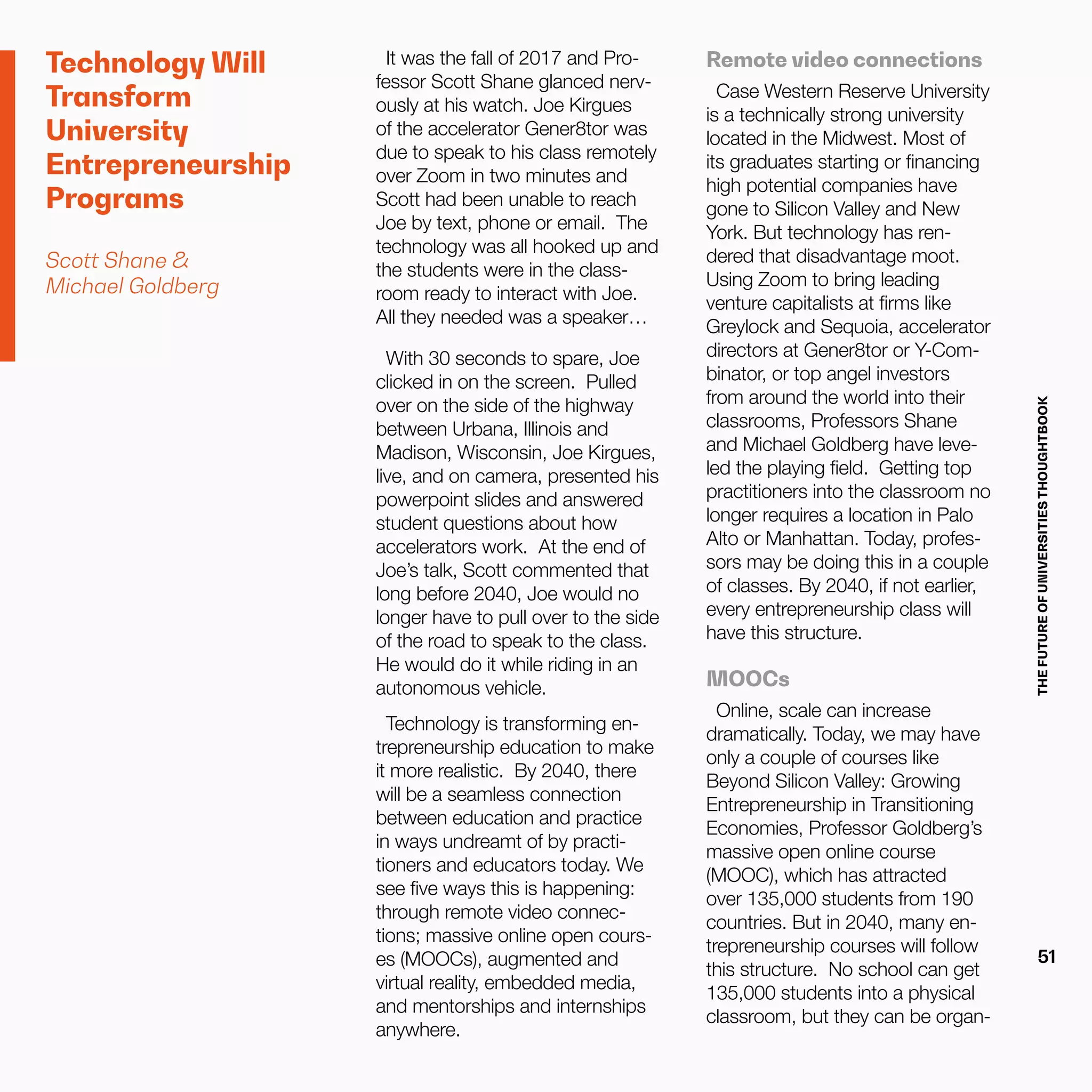
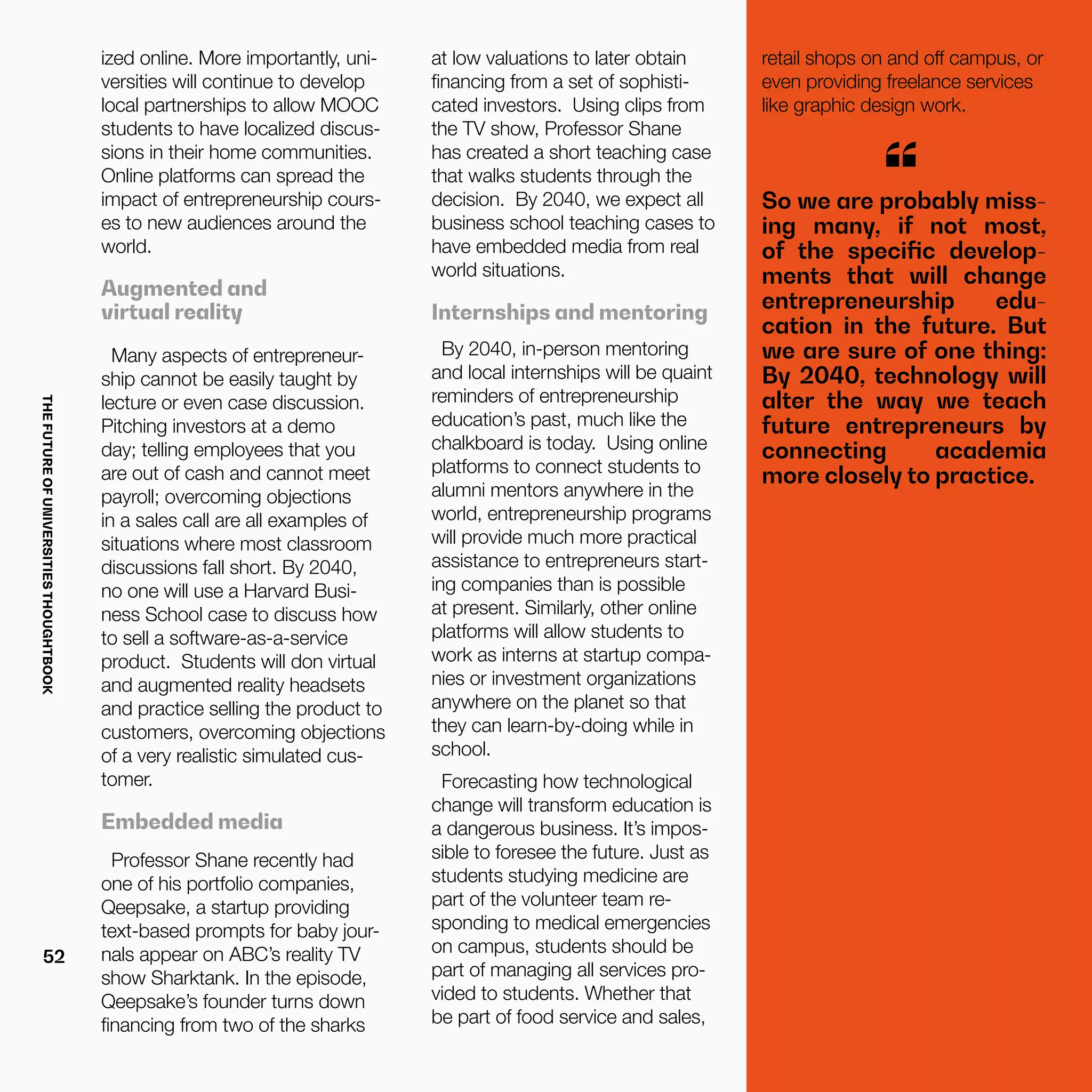





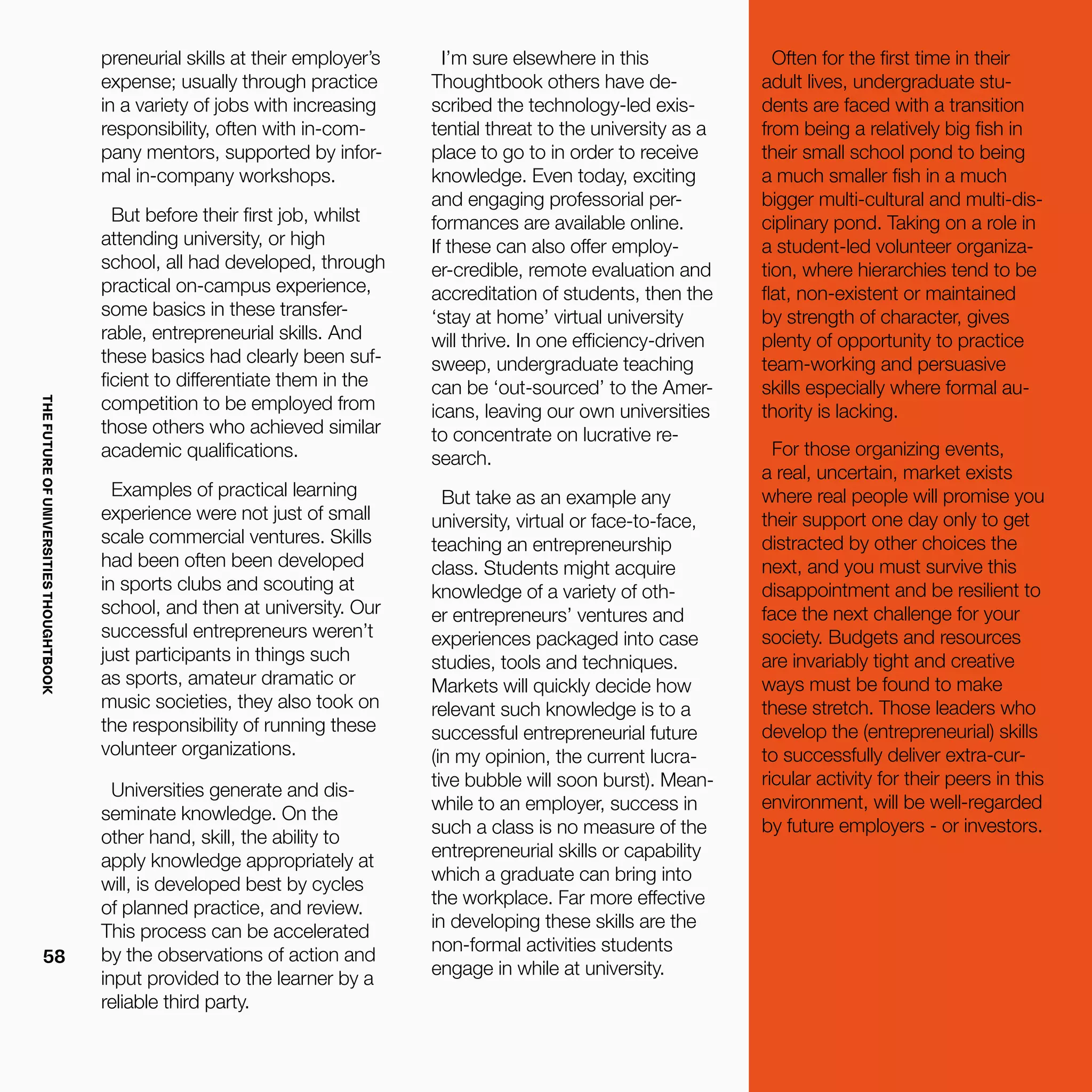

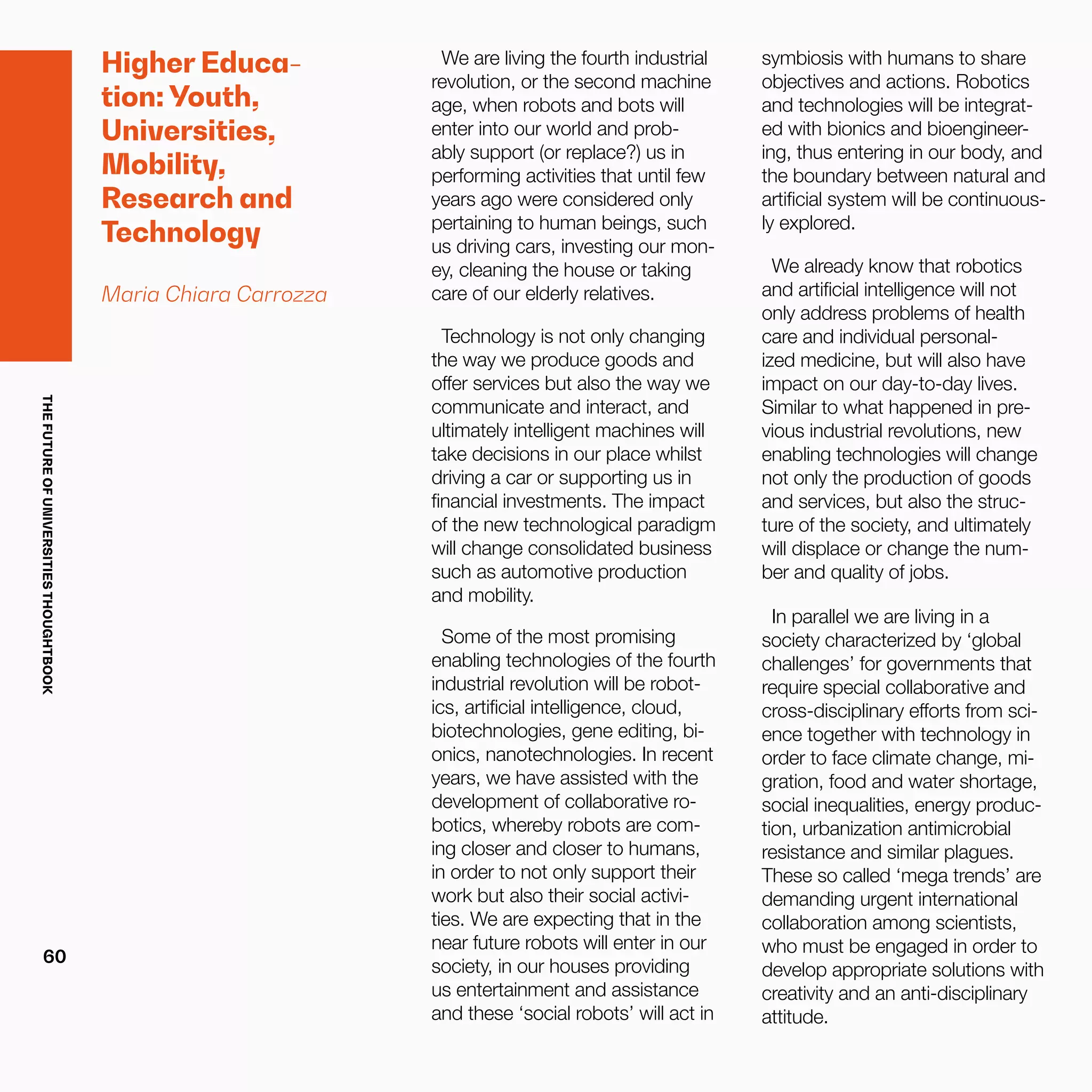




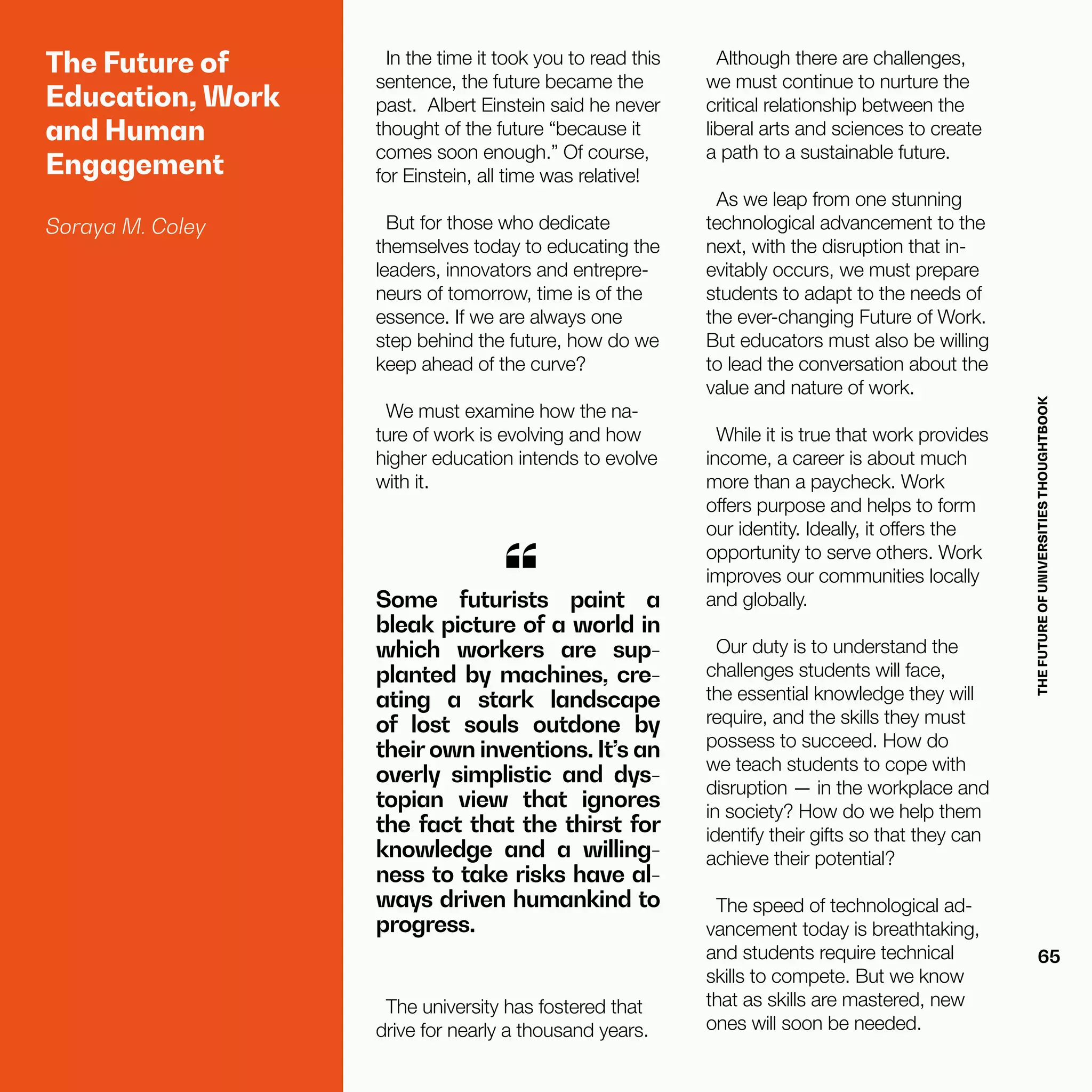
![THEFUTUREOFUNIVERSITIESTHOUGHTBOOK
66
That’s just one reason an educa-
tion cannot focus exclusively on
high-tech proficiency. Students
must be taught to learn and
adapt, and to embrace learning
throughout their lives. Master-
ing new technology is vital, but
thinking critically and learning to
solve problems are the real keys
to unlocking opportunities. In
our growing gig economy, most
people will change jobs at least a
dozen times during their working
lives. If students can gain a mind-
set along with a skill set, they will
be well-positioned to succeed.
A shifting labor landscape
demands adaptability, resilience,
entrepreneurial spirit, cultural com-
petency, perseverance and the
ability to communicate. Equally
important is engagement — mak-
ing the connections that enrich
the human experience.
We already see that artificial intel-
ligence, automation and analytics
are shaping the Future of Work
because they are shaping us now.
But for all the buzz (and the fear)
about AI, there is no question that
the Future of Work has a human
face. It’s inevitable that more of us
will be working alongside ma-
chines and computers to get the
job done, whatever “the job” is.
We already do this today when we
run an Excel spreadsheet or ask
Siri for directions.
Big data alone can never replace
big ideas, but it can help us work
smarter. For humans, adaptation
will yield opportunity.
Rapid change can be over-
whelming, but we’ve been here
before. The Industrial Age brought
life-altering advancements, freeing
us to launch a Digital Age in which
information connects us in ways
once inconceivable.
Although higher education must
keep pace with the needs of the
job market as a vital link between
employers and new graduates,
earning a degree is about much
more than landing a job. The
university of tomorrow cannot be-
come a “coding college” focused
only on job training that cranks
out graduates who have mastered
algorithms but are unable to work
on a team to solve problems.
A broad and deep education,
with less emphasis on the type of
degree a student earns, will en-
sure they remain competitive. So,
what are the core skills that both
a history major and an engineer
need to be successful?
In a 2013 national survey of
business and nonprofit leaders
by the Association of American
Colleges and Universities, 93
percent of respondents said that
“a demonstrated capacity to think
critically, communicate clearly, and
solve complex problems is more
important than [a candidate’s]
undergraduate major.”
As the president of a polytech-
nic university, one of only about
a dozen in the country, I see
firsthand the advantages of an ex-
periential education that offers stu-
dents the opportunity to immerse
themselves in multiple disciplines.
Our faculty emphasizes hands-
on learning where students solve
problems creatively, take intelligent
risks and work collaboratively.
But a comprehensive educa-
tion must provide even more. In
addition to critical relationships
with faculty, students should
engage with their communities,
corporations and local govern-
ment leaders. This is a bedrock of
democracy.
The greatest investment we can
make is in people — to help them
work with others different from
themselves, and to evaluate com-
peting points of view.
“Your brain is not a hard drive,”
Brian David Johnson, futurist in
residence at Arizona State Uni-
versity’s Center for Science and
Imagination, told the audience
at an Adobe Think Tank conver-
sation in early 2017. He believes
machines will take over most jobs
in the coming decades, but says
people shouldn’t worry.
“We need to embrace what hu-
mans are good at,” Johnson said.](https://image.slidesharecdn.com/fut-global-edition-190706112625/75/Fut-global-edition-66-2048.jpg)
![THEFUTUREOFUNIVERSITIESTHOUGHTBOOK
67
“We’re great communicators. We
have emotional intelligence. All of
this [automation] frees us up to be
more human.”
And he is encouraged that more
free time will mean more opportu-
nity to raise the standard of living
for everyone: “I tell people if you
want to prepare for the jobs of the
future, just be human.”
We also know that the face
of humanity in the workplace is
increasingly diverse, and that
with ethnic, racial and gender
difference comes diversity of
perspective and experience. As
educators, we must insist on an
inclusive mission that makes clear
how to engage a diverse student
body and the communities we
serve.
We must help create a society
that values lifelong learning by
making education more accessi-
ble, especially for the adult learner.
Online education will continue
growing and technology will ena-
ble information to be shared more
widely.
The Future of Work is about
more than automation, calculation
and faster computers. It’s about
adaptation, human engagement
and what deep learning and
meaningful work can bring to
individuals’ lives and the collective
good. It’s about our connected-
ness to each other.
Rather than simply responding to
the nation’s future needs, higher
education must help set the agen-
da. By preparing students today,
we set a course for tomorrow’s
success.
Because Einstein was right, of
course. The future is already here.
1
It Takes More than a Major: Employer
Priorities for College Learning and Student
Success (2013). Washington, DC: Association
of American Colleges and Universities and Hart
Research Associates.
Dr. Soraya Moore Coley believes
that a quality education remains
one of the few pathways to social
and economic well-being in a global
society. Often referred to as a “stu-
dent-centered and community-mind-
ed” administrator, Dr. Coley has built
bridges between the university and
the community through her service,
her research, and her work as an
administrator. With over 28 years of
academic and administrative experi-
ence, Dr. Coley is the sixth President
of California State Polytechnic Univer-
sity, Pomona and the first woman to
serve in that role.
Previous appointments included
Provost/Vice President for Academic
Affairs at California State University,
Bakersfield, and Senior Research
Fellow at Children and Family Future’s
National Center on Child Welfare and
Substance Abuse. At Alliant Interna-
tional University, she was the Provost/
Vice President for Academic Affairs
and is Professor Emeritus at California
State University, Fullerton, where she
also served as Dean of the College of
Human Development and Community
Service. Dr. Coley earned her bache-
lor’s degree in sociology and received
an honorary doctorate of humane
letters from Lincoln University (PA),
and her MSW and Ph.D. degrees in
Social Planning and Policy at Bryn
Mawr College’s School of Social Work
and Social Research.
THEFUTUREOFUNIVERSITIESTHOUGHTBOOK
67](https://image.slidesharecdn.com/fut-global-edition-190706112625/75/Fut-global-edition-67-2048.jpg)
![THEFUTUREOFUNIVERSITIESTHOUGHTBOOK
6868
In 2040,
Universities
Will Be a Place
of Dreams
Michael Bolle
In 2040, universities will be a
place of dreams, much more so
than today. As early as 1929,
Albert Einstein said it best in an
interview: “Imagination is more
important than knowledge. For
knowledge is limited […].” As
time progresses, universities will
no longer be places of training
for administrative elites whose
life purpose is to maintain and
expand power at the state lev-
el. Rather, institutions of higher
learning will increasingly reflect the
ideal that the quest for truth calls
for freedom.
To a certain degree, this will mark
a return to the roots of universities,
to the academies of the Antique
era in Athens and Alexandria.
When the world’s first universities
opened 900 years ago in Bologna
and Paris with the amalgamation
of different schools that were or-
ganized by students themselves,
Europe took the lead.
The universities of the future
will also increasingly be voluntary
shelters of the mind in the quest
for new ideas. This will not hap-
pen automatically, as there will be
resistance. The universities of the
future will have to fight for their
independence and special rights,
as they once had to against kings,
bishops, and cities. This time,
however, states, religions, and
economic monopolies will be re-
placed with commercial interests.
At their core, universities will also
remain communities of teachers
and learners that enjoy a special
legal status.
If students, professors, research-
ers, and practitioners continue to
meet and spend time together
at unique historical locations,
there will be continuity. However,
the campus of the future will be
expanded to the entire world with
the help of new technologies. The
virtual reality of the future will erase
geographical boundaries. It will
thus become possible to attend
lectures and seminars at Harvard,
in Leipzig, Capetown, or Beijing,
as presence will no longer be
linked to physical location. Holo-
grams will be created that will not
merely resemble ghosts, but will
have the technical ability to see
the bright light of New England,
feel the African sand between their
toes, or taste the flavor of Oolong
tea.
While past university classes
were marked by the spoken word,
unspoken thought will become
more relevant in the future. This
will be made possible by new
technologies that will combine
face recognition with the interpre-
tation of reactions and tempera-
tures, as well as the interpretation
of electrical impulses based on
individual behavioral patterns. The
aim here will not be to control or
even restrict thought. Rather, the
objective will be to practice and
apply logical conclusions and
THEFUTUREOFUNIVERSITIESTHOUGHTBOOK](https://image.slidesharecdn.com/fut-global-edition-190706112625/75/Fut-global-edition-68-2048.jpg)




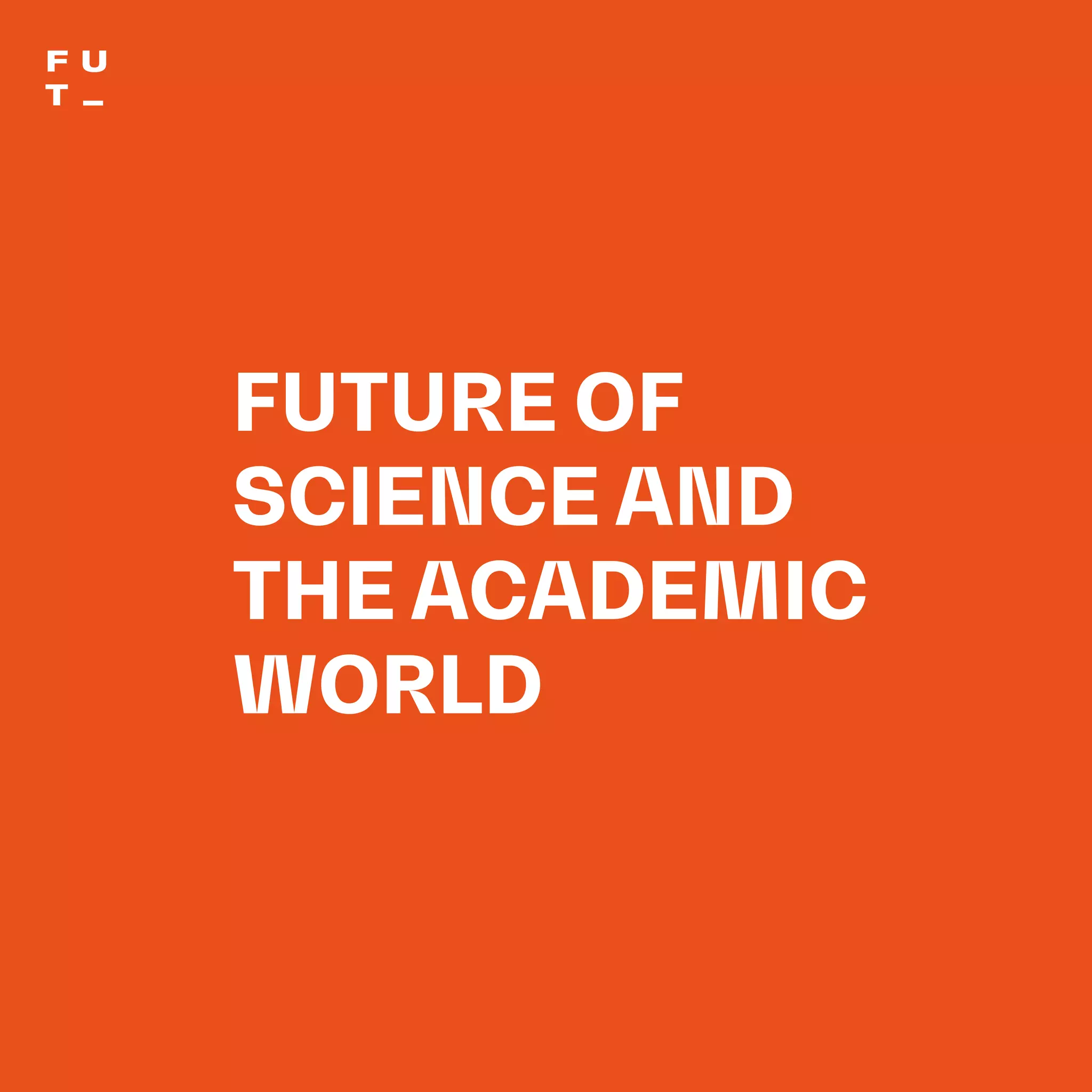





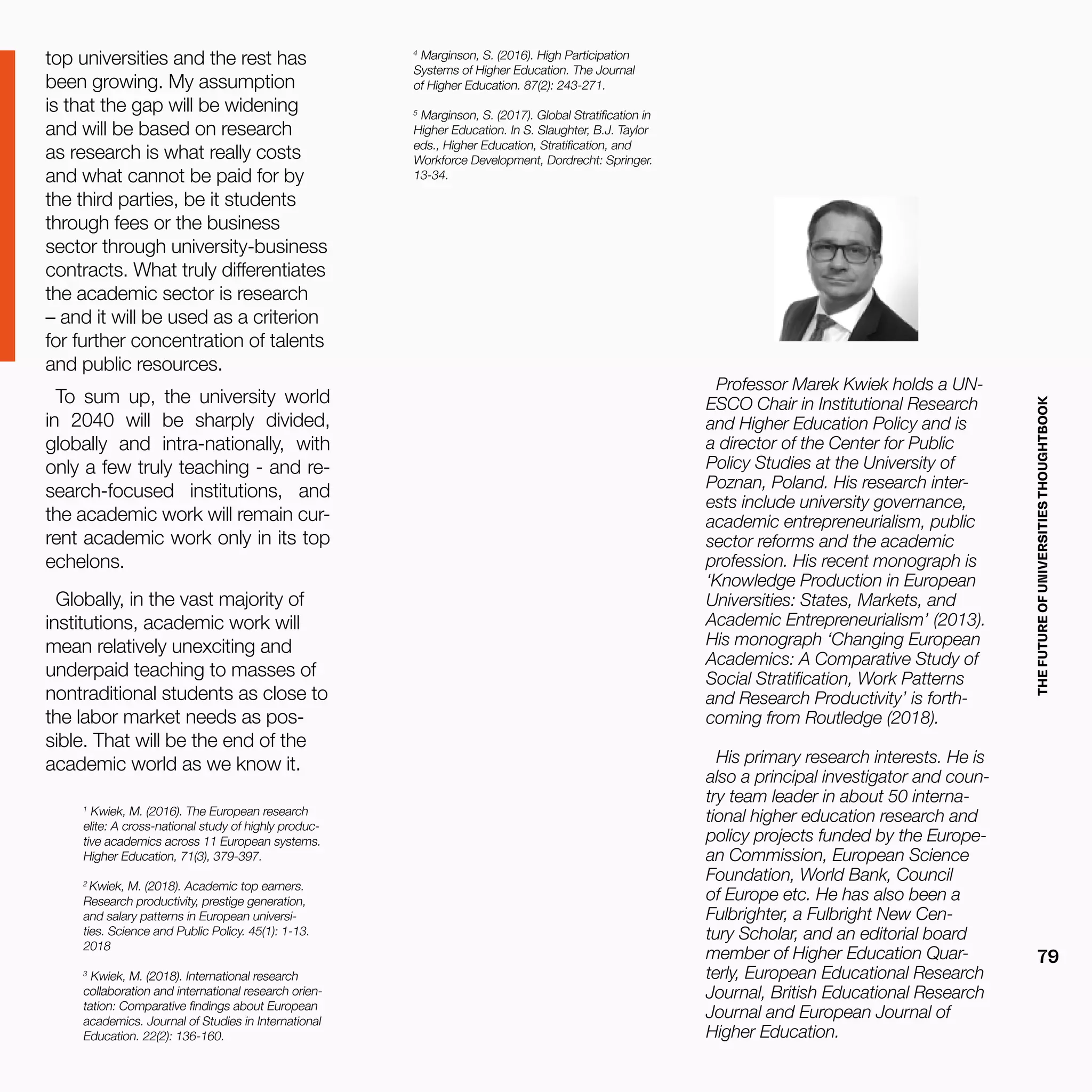


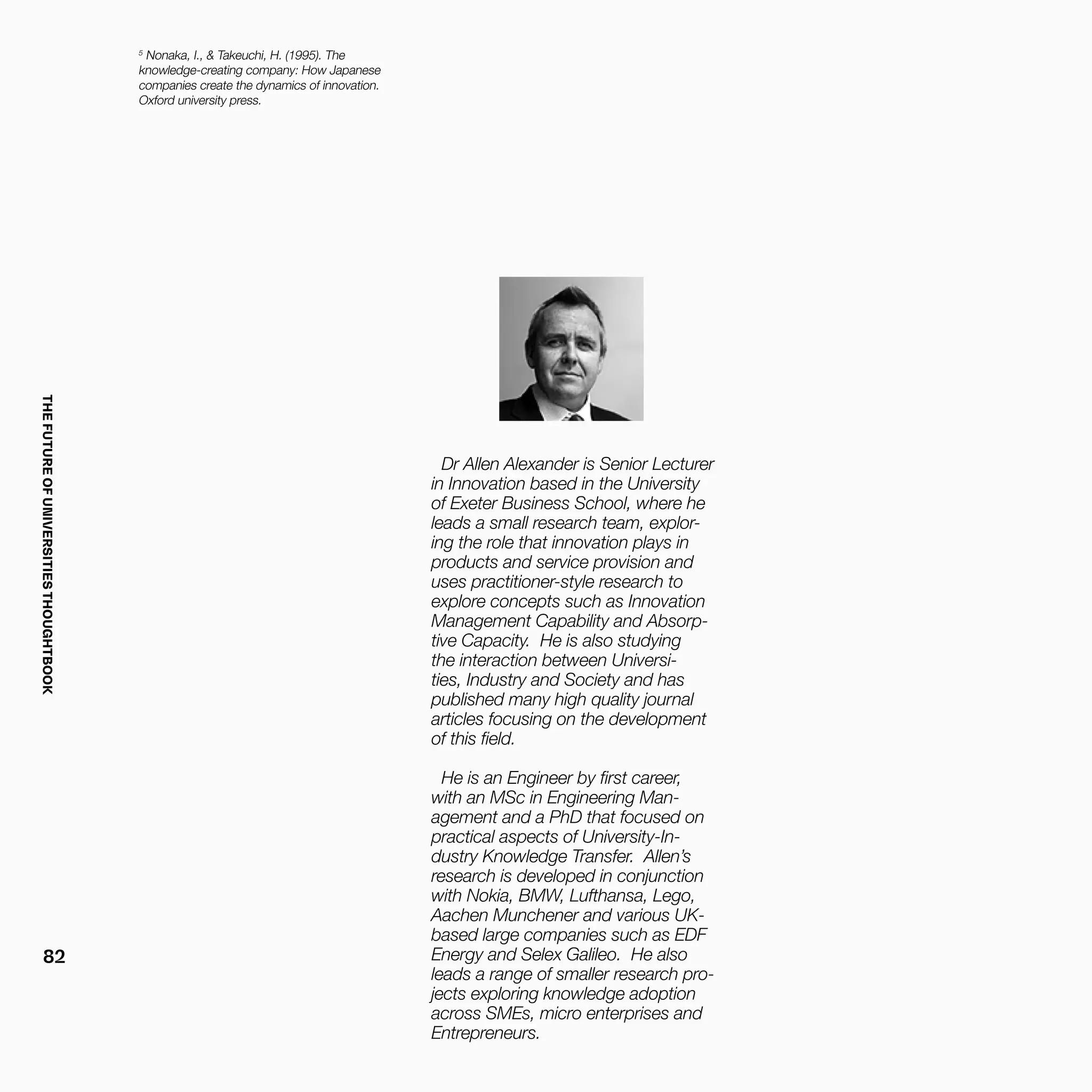
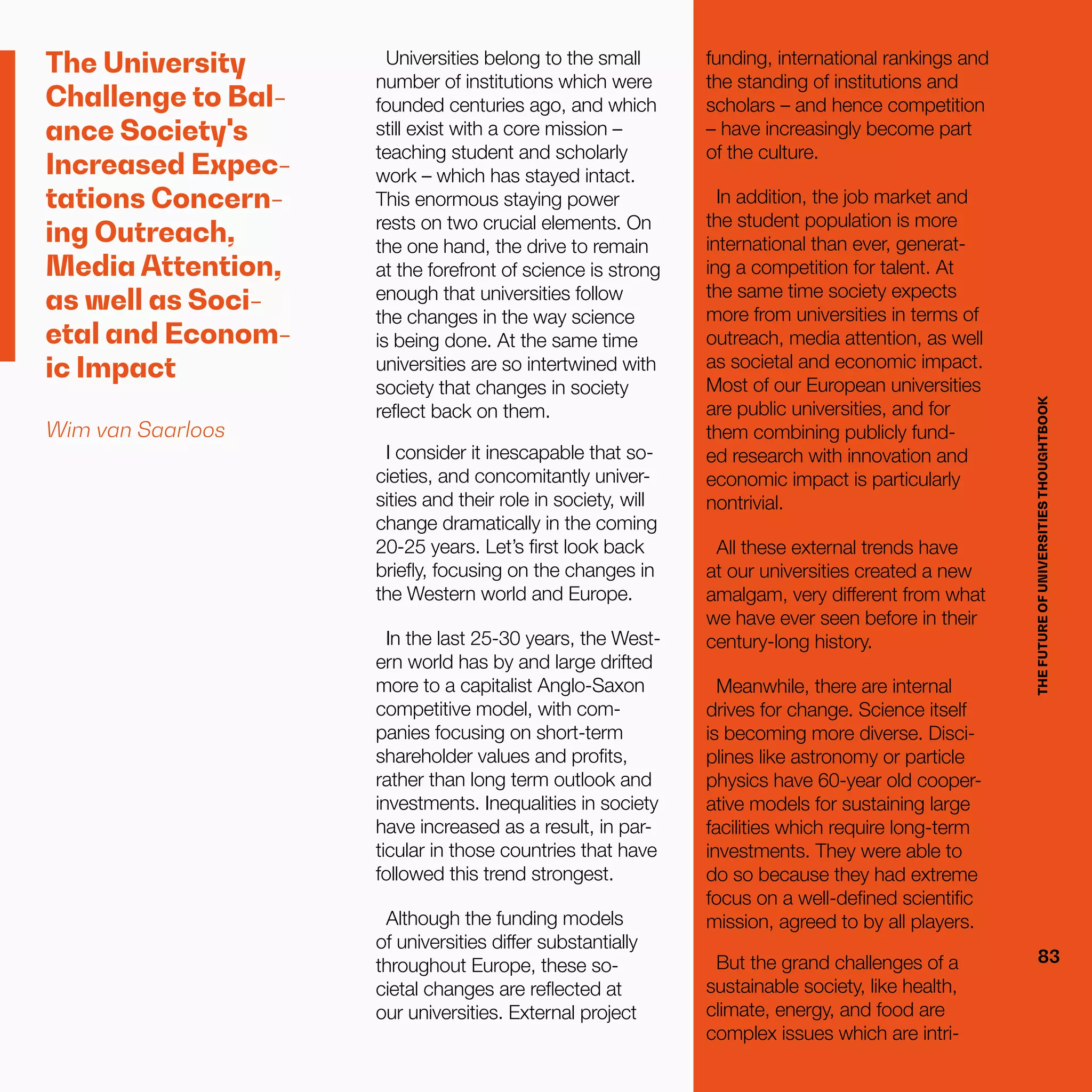
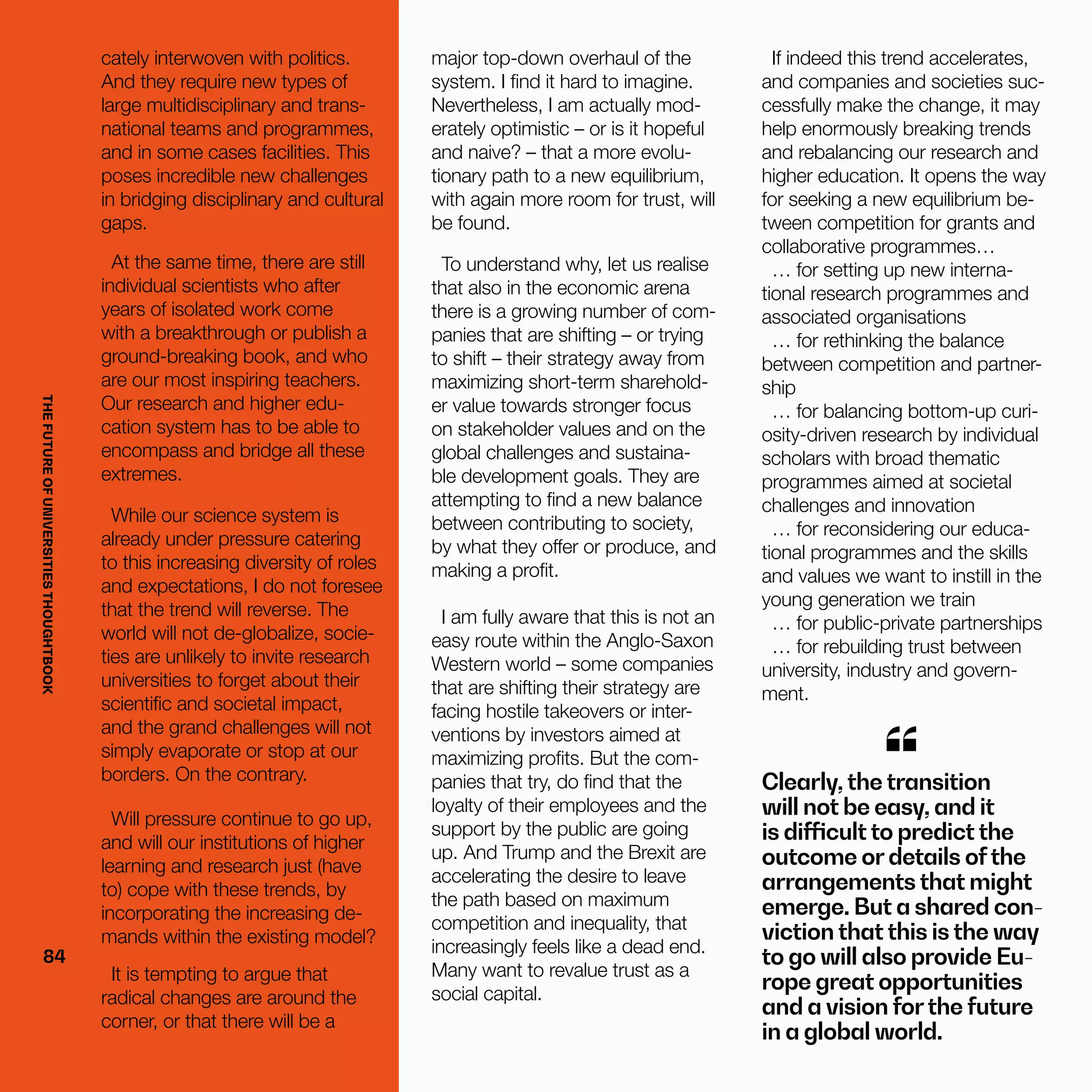

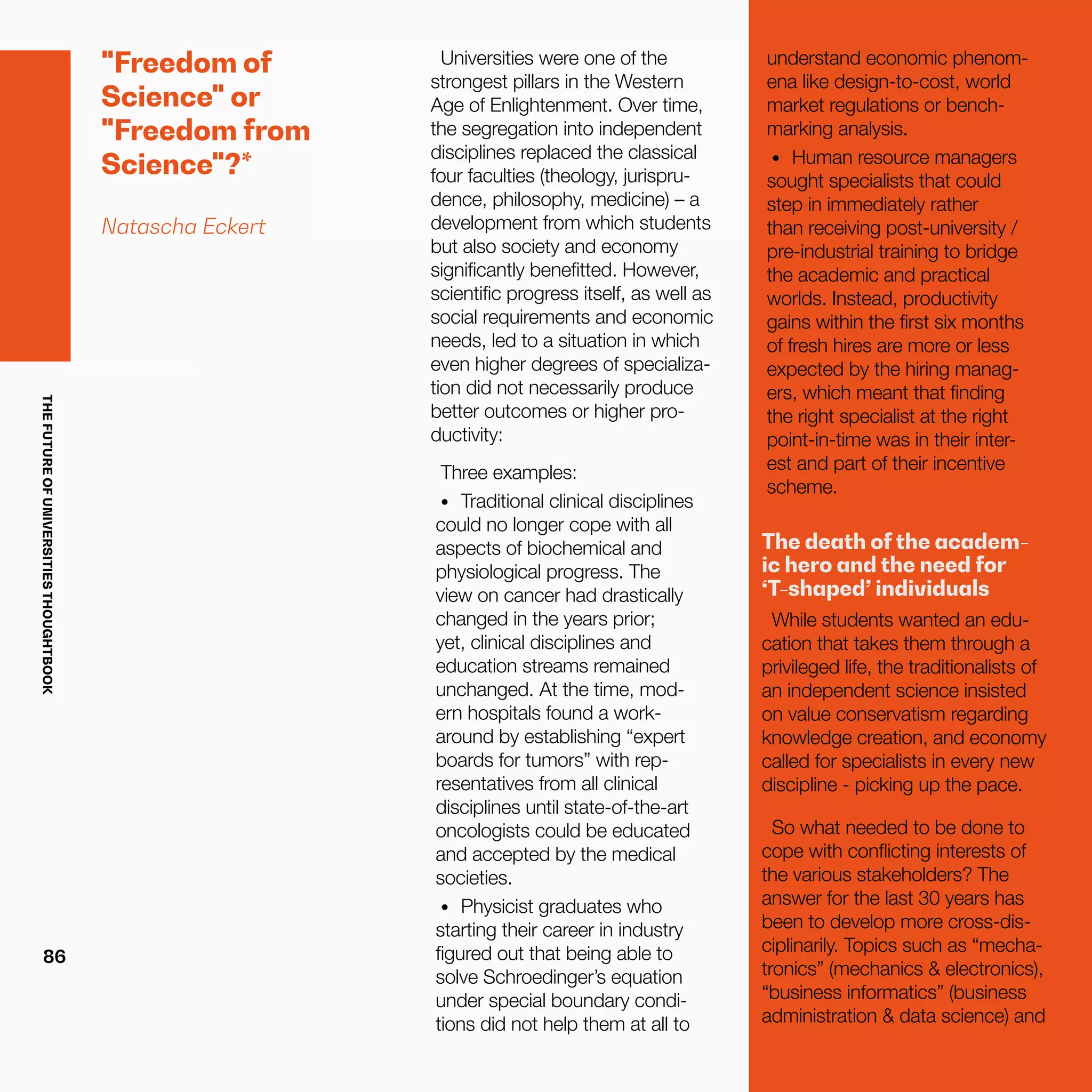


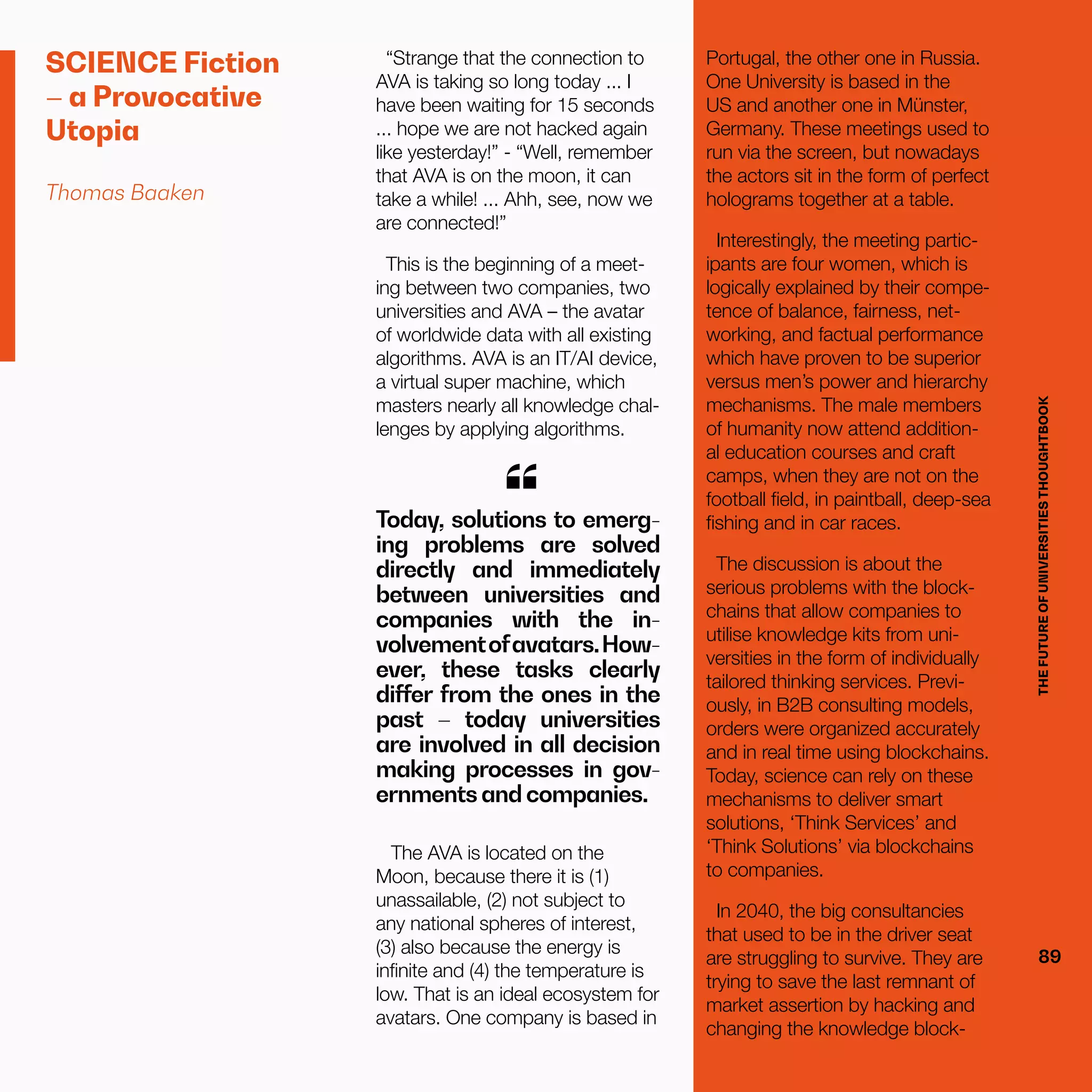



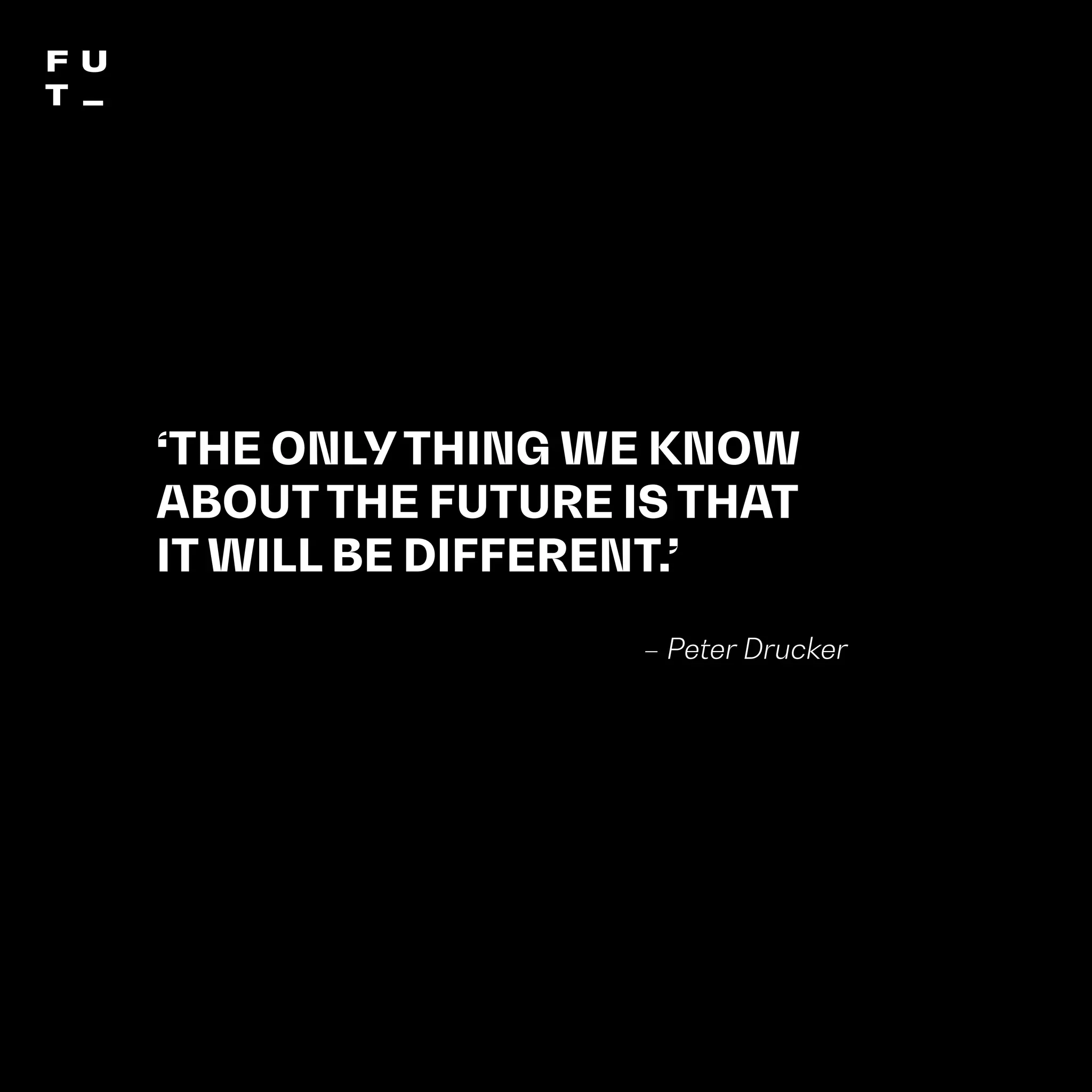
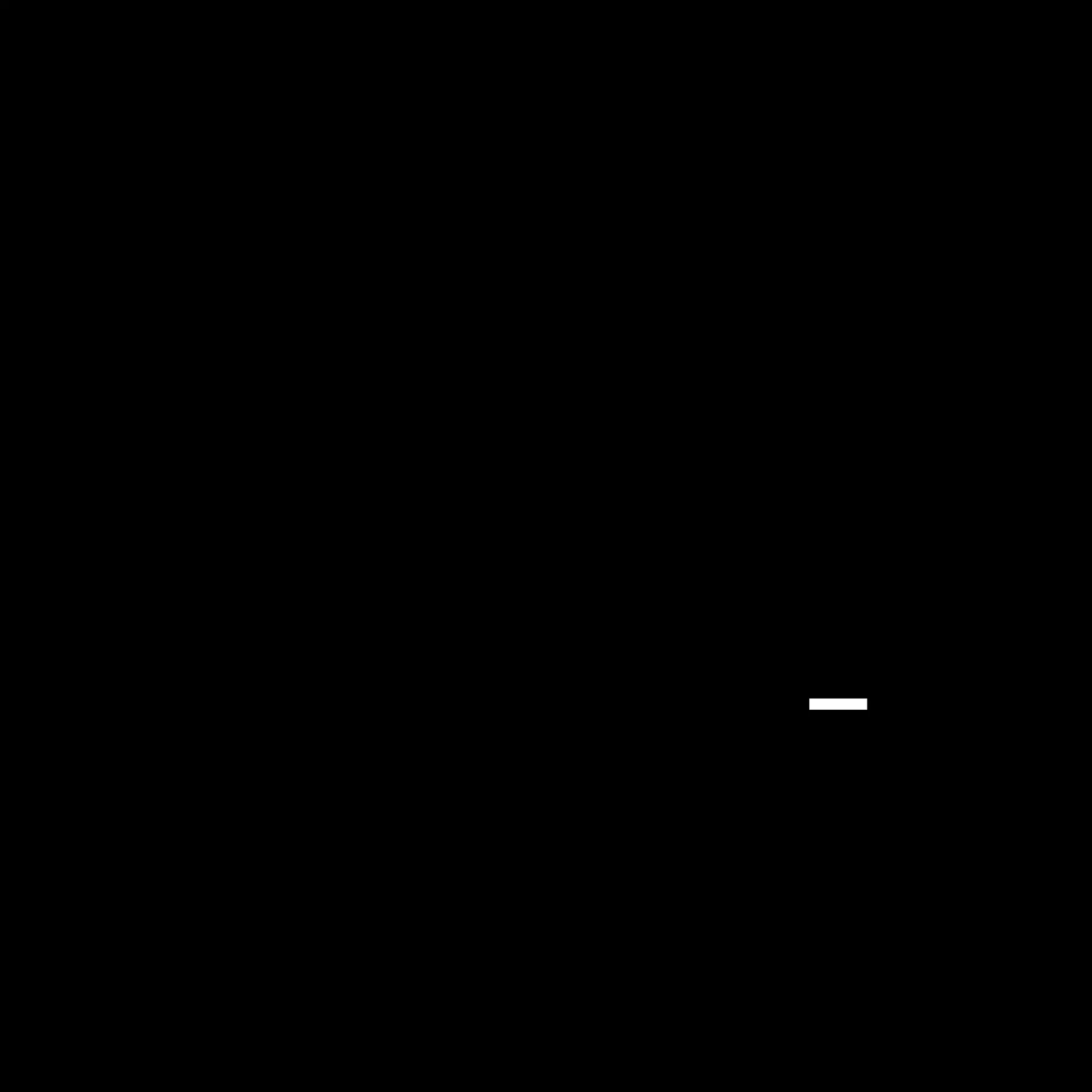



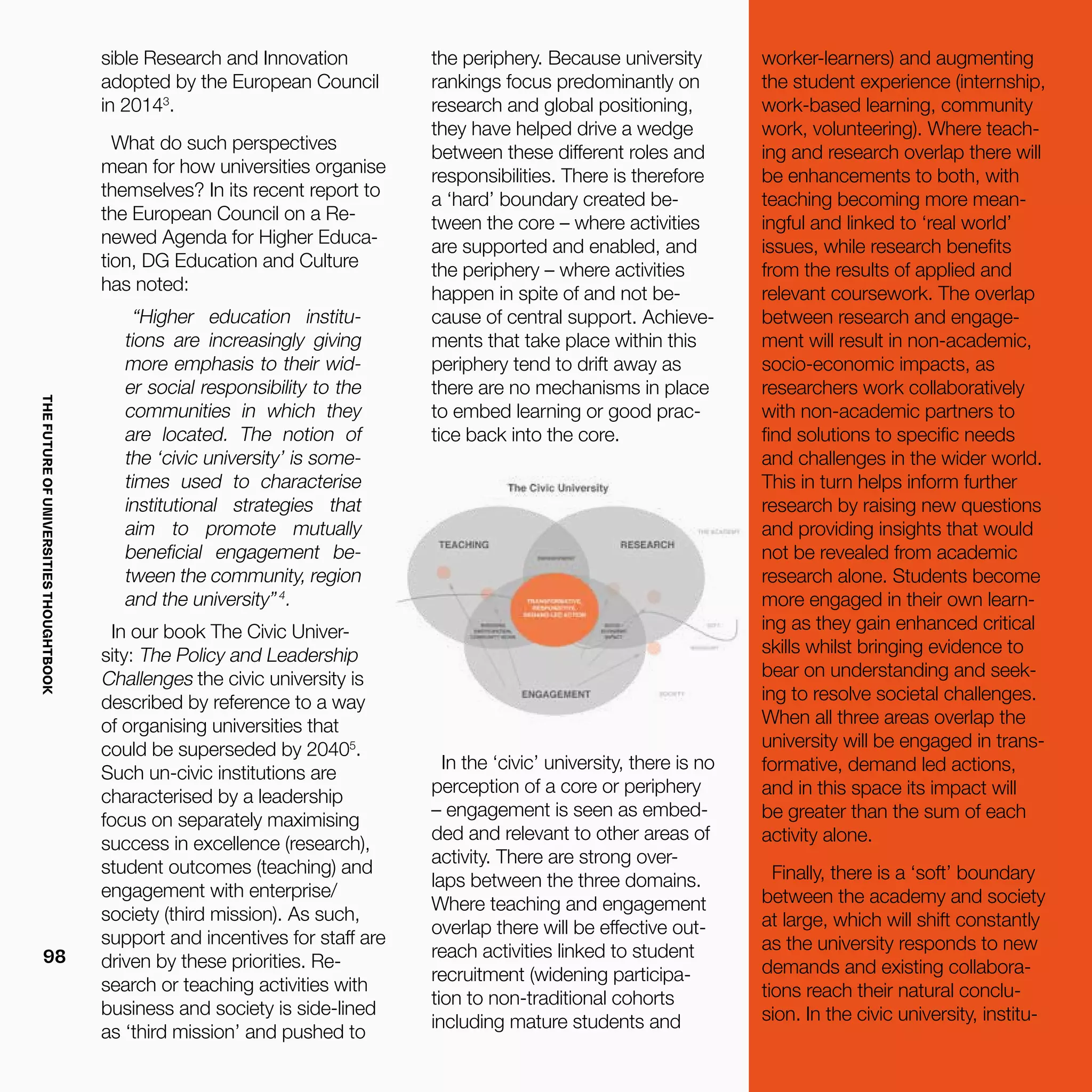
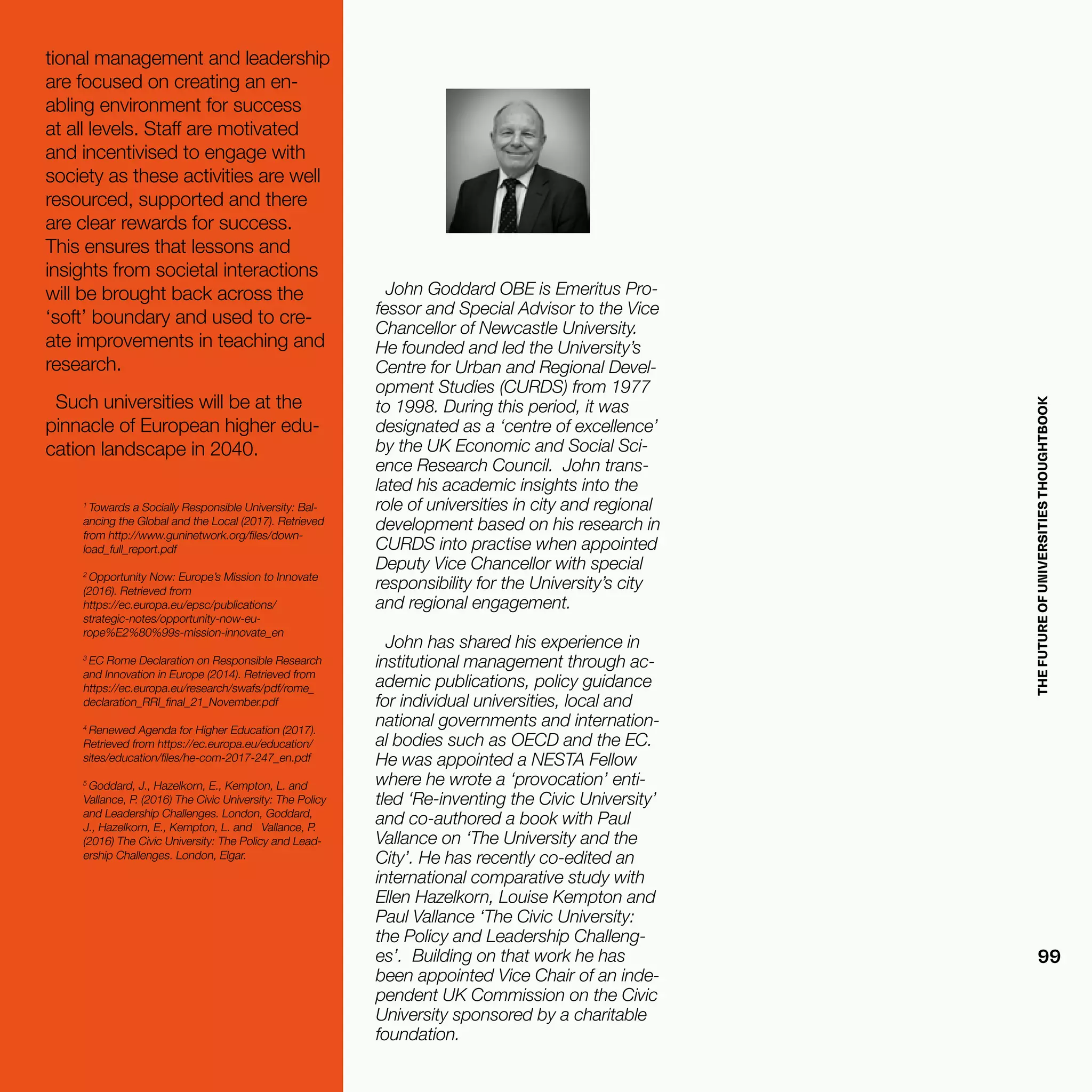
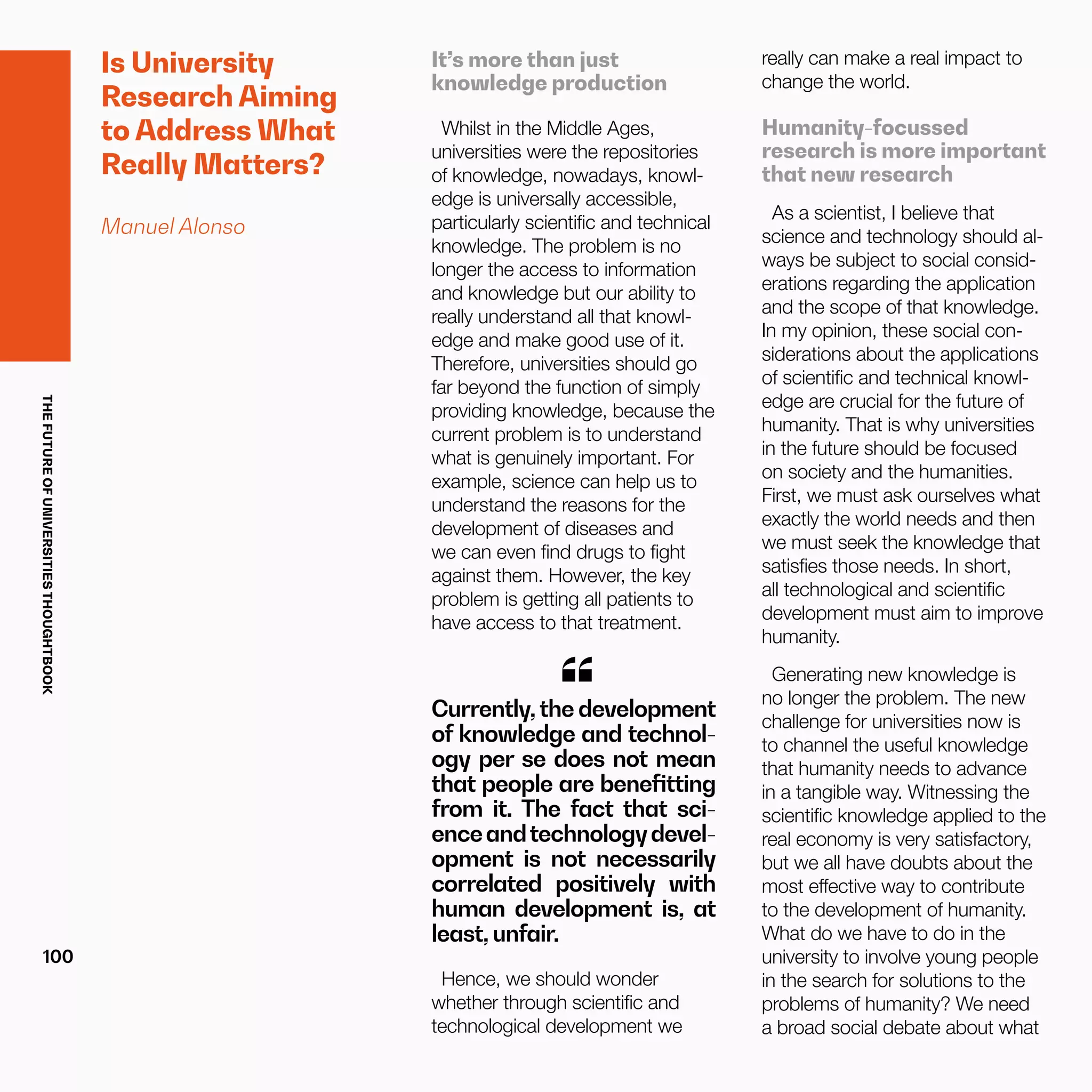
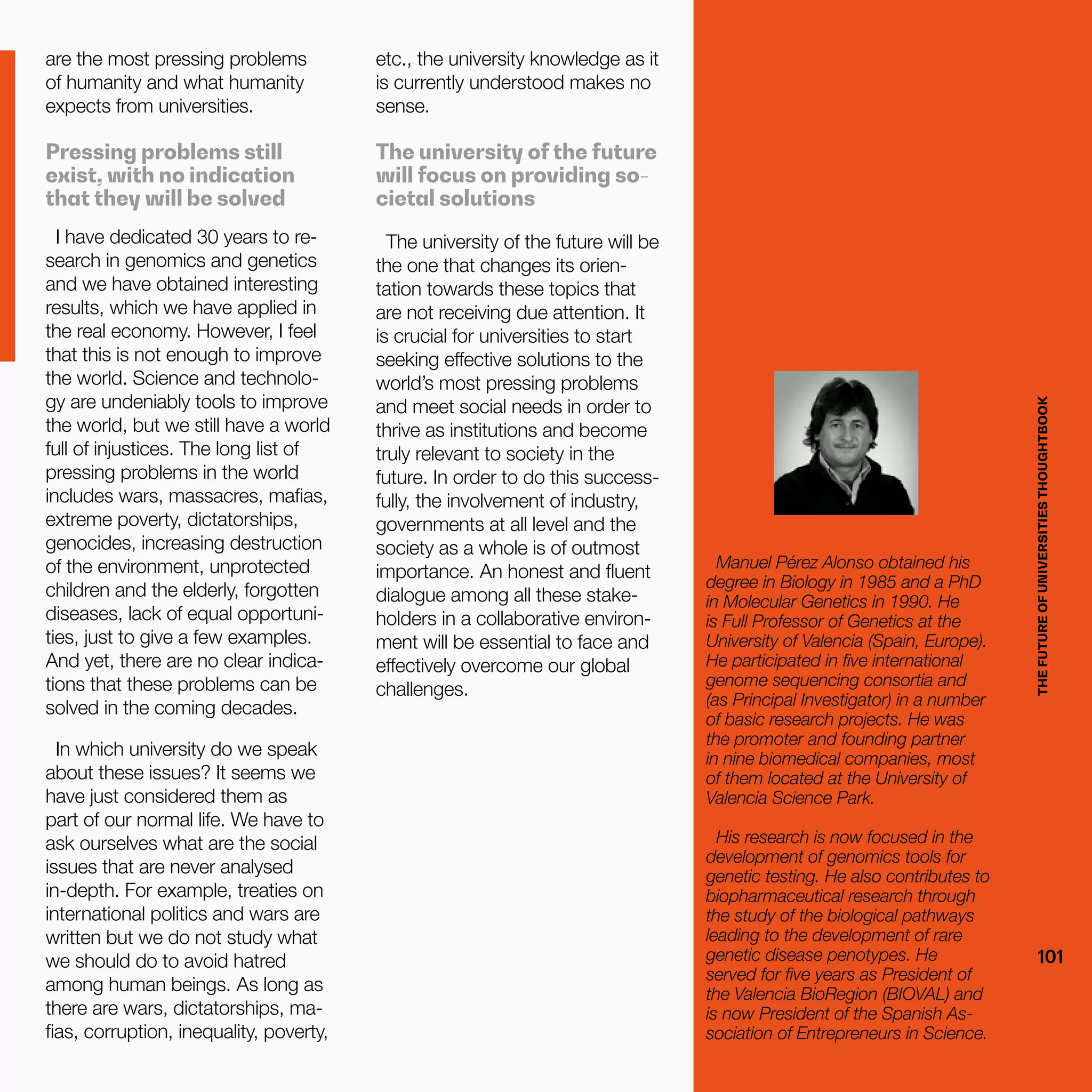











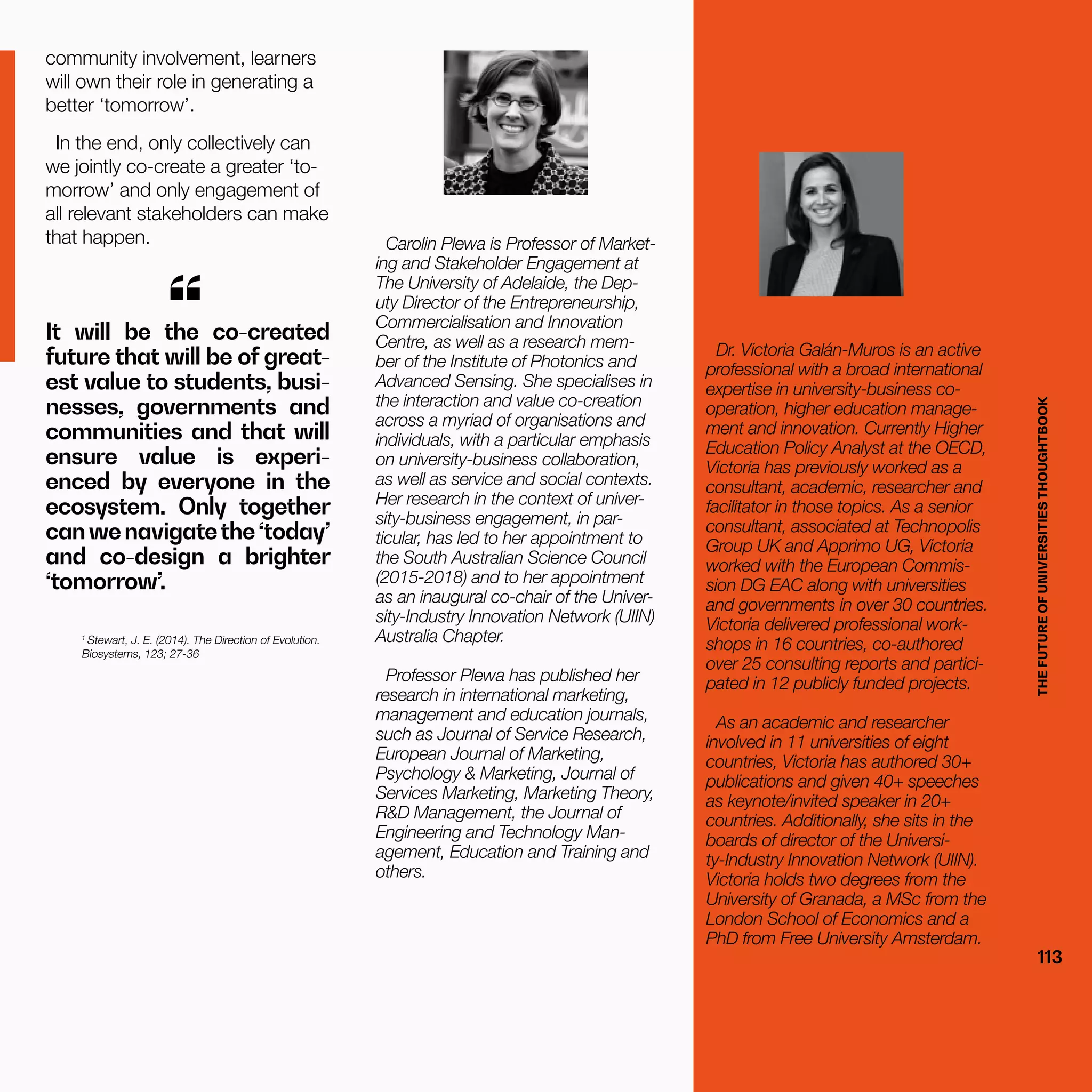
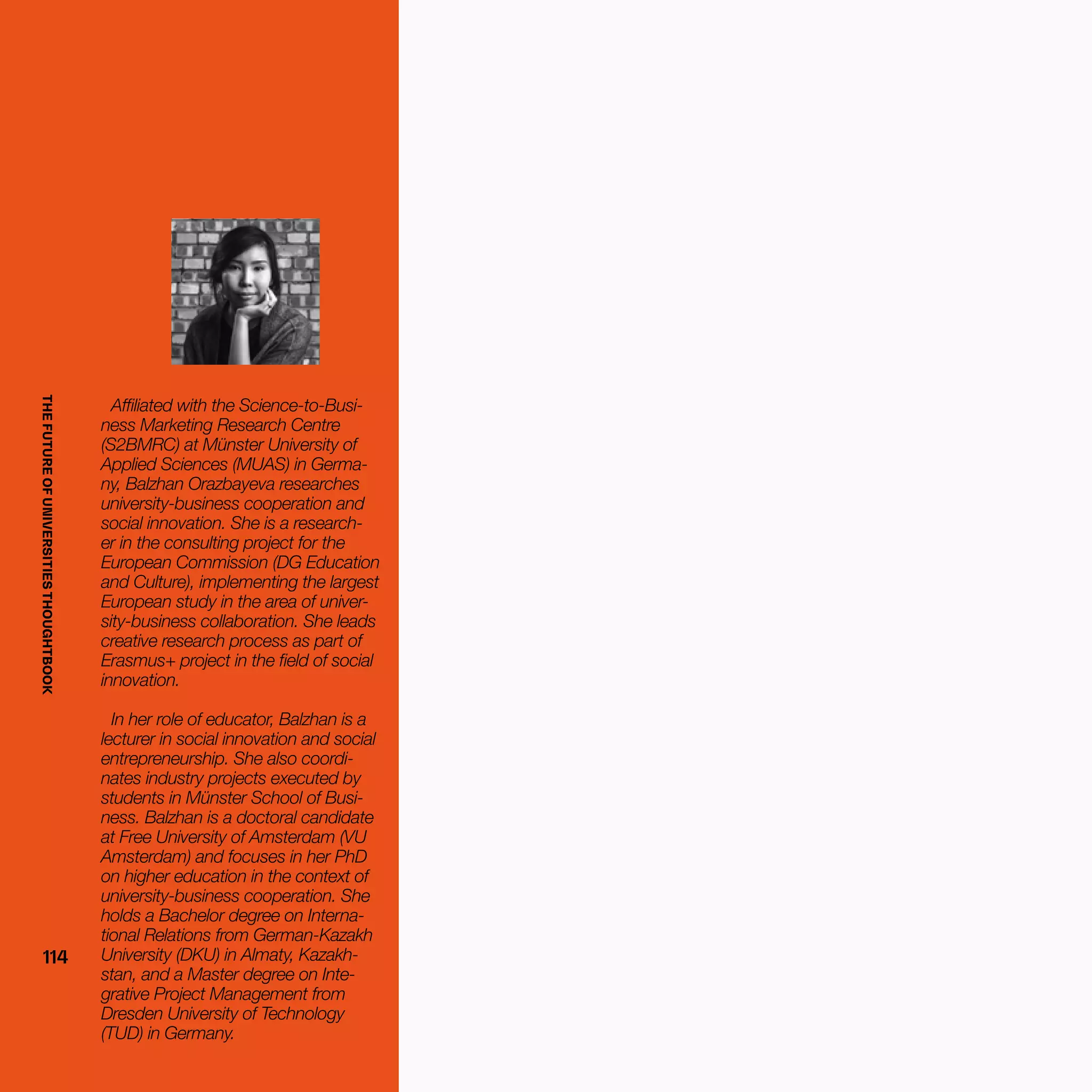

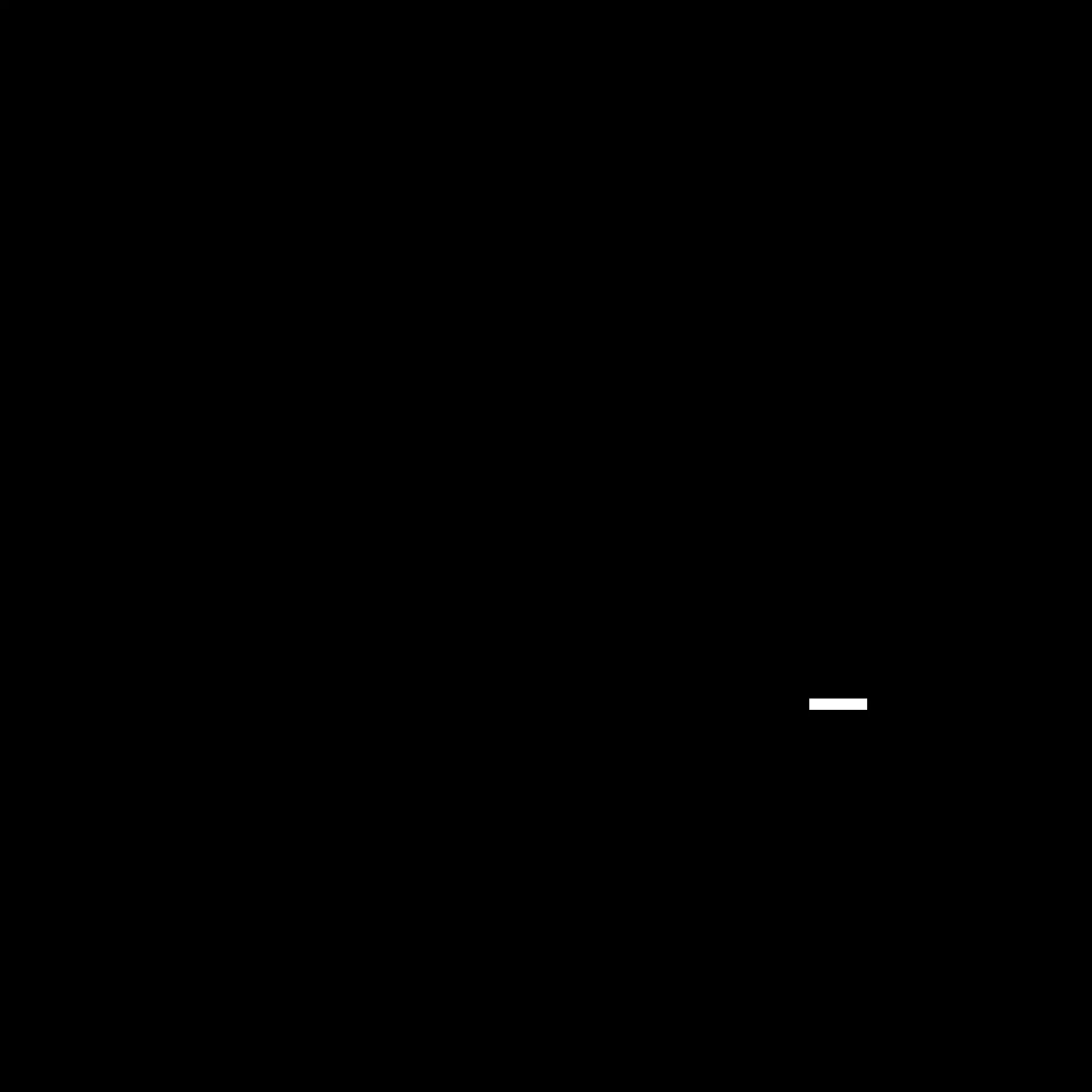



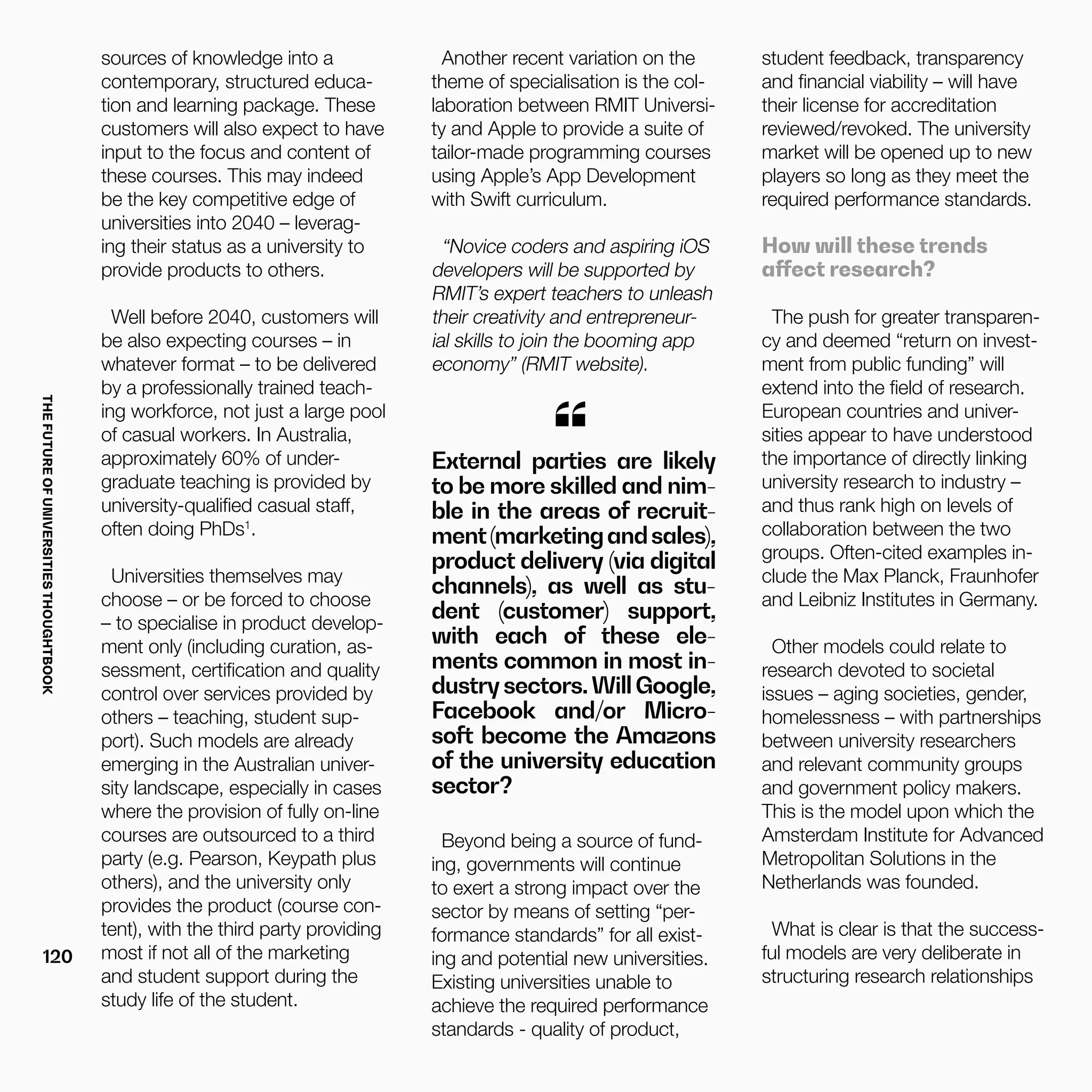


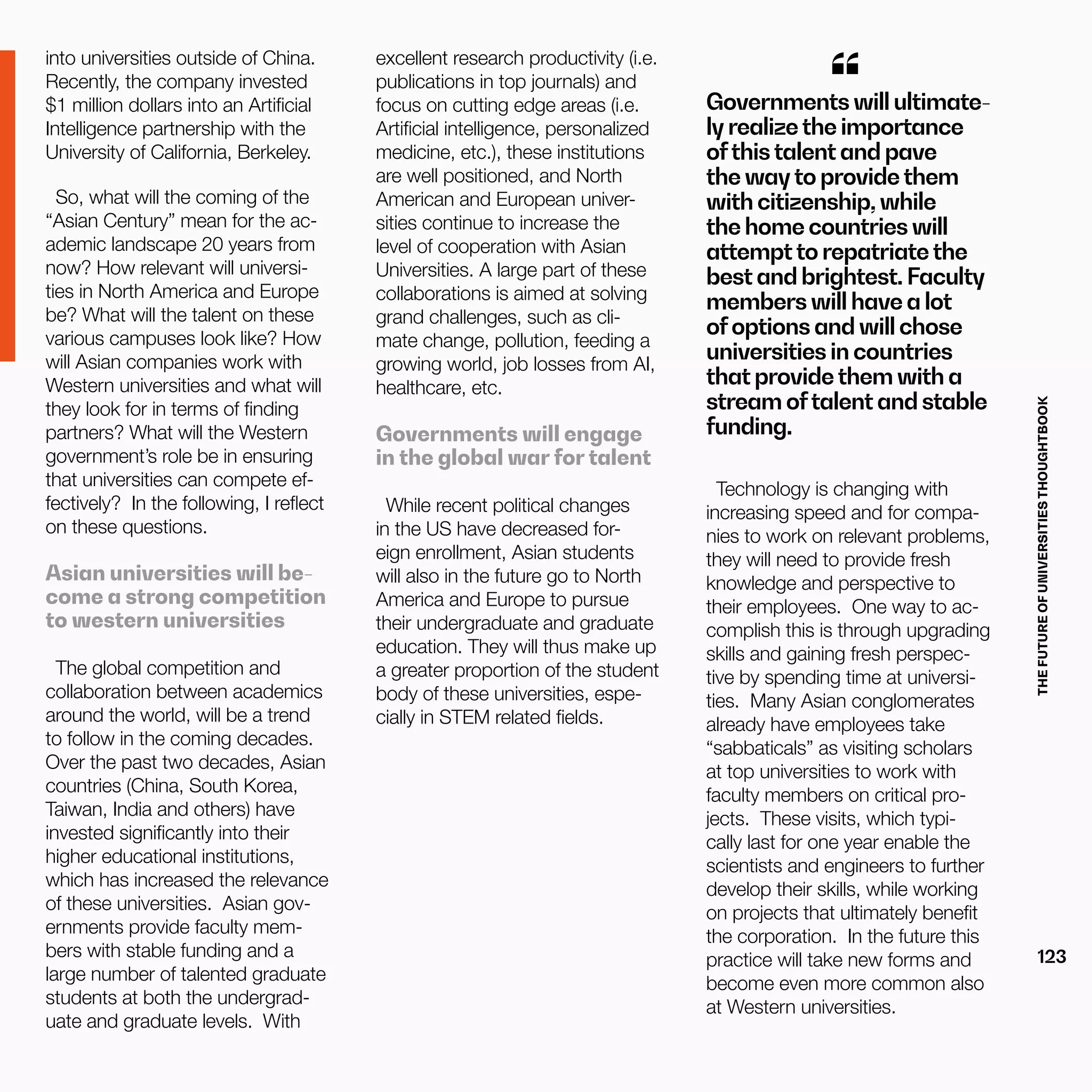




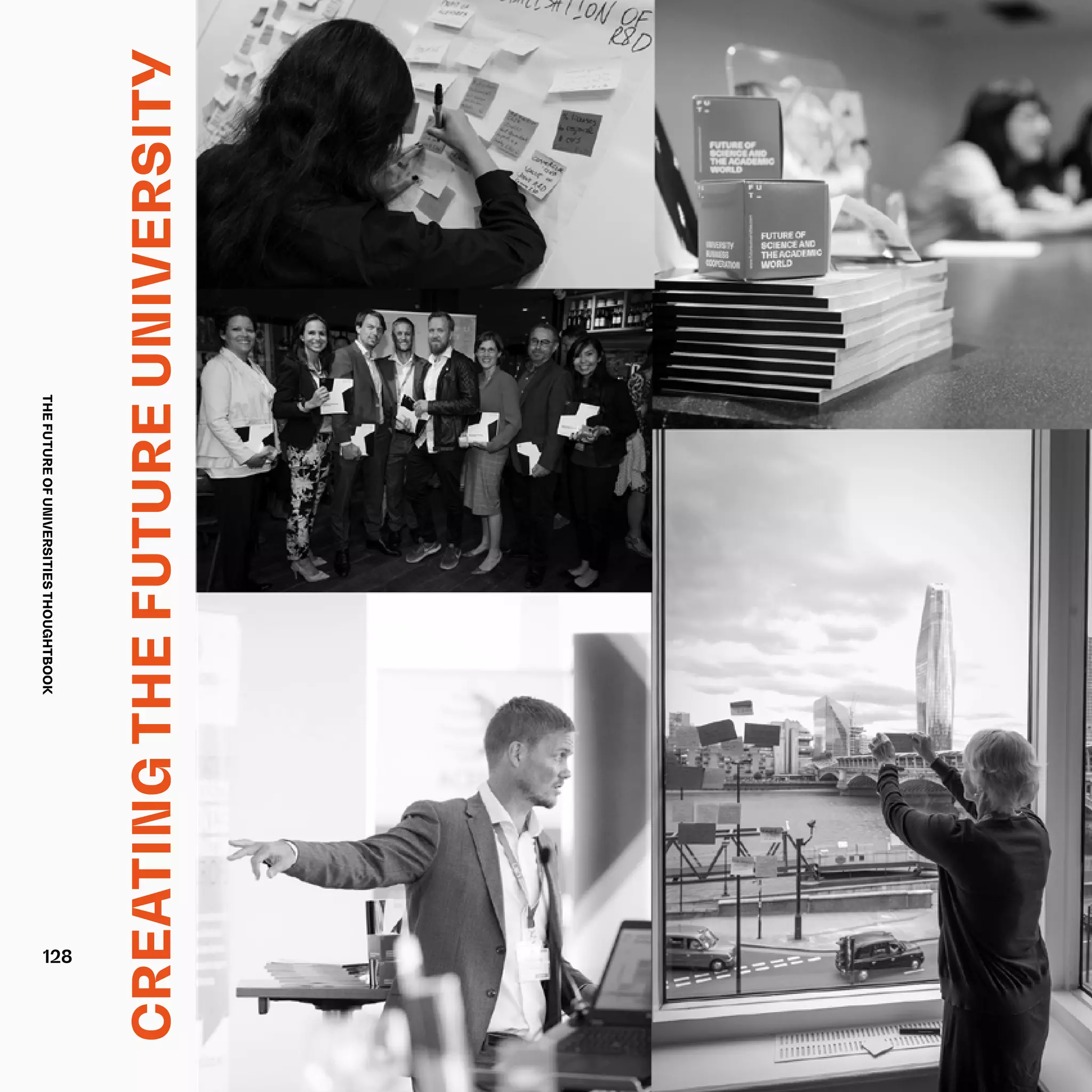




![THEFUTUREOFUNIVERSITIESTHOUGHTBOOK
133
In this time of the fourth in-
dustrial revolution, when
the race against (with) the
machines will be the sin-
gle defining feature of the
future workforce, it is im-
portant that we design the
student learning journey
so that it equips our grad-
uates for a future world of
work, and not just for the
here and now7
– not just
the graduate job that is
secured within six months
afterthey graduate8
.
“
Stepping beyond
automation
Universities that become inside
out will embrace the co-location
of industry clusters around them
and the at-scale use of immersive
(virtual) online learning platforms,
MOOCs, and active employer
involvement will make the ‘work
room’ the everyday classroom
where the boundaries between
these settings will merge. Stu-
dents will start their studies not
with theory but in active learning
settings based on ‘real prob-
lems’ in business. This will flip the
learning environment from text
books and classrooms to a more
immersive and interactive learning
experience for students. Practice
and theory will be part of a single
learning experience.
the context of automation, the
challenge for the universities of
2040 will be finding ways to ena-
ble individuals to embrace a world
where ‘to be employed is to be
at risk [and] to be employable is
to be secure’11
, yet recognising at
the same time that any such no-
tion of ‘security’ is unachievable12
.
Some may argue that these
approaches to university-business
co-operation already exist. But do
they go far enough? For the world
of work to be an immersive part of
the learning experience, universi-
ty-business co-operation needs to
be far more radical and progres-
sive9
. It is suggested that this will
require a model of higher edu-
cation similar to that advocated
by KaosPilot in Denmark, where
the learning is situated in practice
from the start, it is not just an op-
tional ‘business skills’ module but
the outside-in is an engaged and
active part of the learning experi-
ence. The KaosPilot10
is a hybrid
business and design school that
recognises that an entrepreneurial
education leads not only to stu-
dents getting good jobs, but that
it enables them to create new and
exciting jobs for the future. Rather
than reducing the experience to a
job after graduating that is char-
acterised by traditional methods
of measurement – a Standard Oc-
cupational Code, and determining
value by some artificial measure of
graduate earnings, for many stu-
dents, the KaosPilot experience is
more about finding a career with
meaning and purpose.
The active co-design of learning
will give voice to university, em-
ployer and student, and ensure
that learning goes beyond simply
being a functionalist device for
employers to fill skills gaps and
shortages. Ultimately though, in
1
CBI and Pearson (2016). The Right Combination:
CBI and Pearson Education and Skills Survey.
Retrieved from: http://www.cbi.org.uk/cbi-prod/
assets/File/pdf/cbi-education-and-skills-sur-
vey2016.pdf
2
Rich, J. (2016). Employability: Degrees of value.
Occasional Paper 12, HEPI. Oxford.
3
See Boulton G, Lucas C. (2011). What are univer-
sities for? Chinese Science Bulletin, Vol. 56, No.
23; Chertskovskaya, E., Watt, P., Tramer, S., and
Spoelstra, S. (2013). Giving notice to employability,
Ephemera: Theory and Politics in Organization, Vol
13, No. 4, Mayfly Books; Collini, S. (2012). What
are universities for? Penguin.
4
Ford, M. (2016). Rise of the Robots: Technology
and the Threat of a Jobless Future. Oneworld
Publications.
5
Bakhshi, H., Downing, J., Osborne, M., & Schnei-
der, P. (2017). The Future of Skills: Employment in
2030. London: Nesta, Oxford-Martin, Pearson.
6
Ibid CBI and Pearson, 2016
7
Schwab, K. (2015). The Fourth Industrial Rev-
olution: what it means, how to respond. Foreign
Affairs Anthology Series.
8
Holmes, L. (2006). Reconsidering Graduate Em-
ployability: Beyond PossessiveInstrumentalism.
Presented at the Seventh International Conference
on HRD Research and Practice Across Europe,
University of Tilburg.
9
Herrmann, K., Hannon, P., Cox, J., Ternouth, P.,
& Crowley, T. (2008). Developing entrepreneurial
graduates: putting entrepreneurship at the centre
of higher education. London: NESTA.
10
Elbaek, U. (2006) KaosPilot A-Z. Retrieved from:
www.kaospilots.dk
11
Hawkins, P. (1999). The art of building windmills:
Career tactics for the 21st century. Liverpool:
Graduate Into Employment Unit, University of
Liverpool.
12
Costea, B., N. Crump and K. Amiridis (2007).
Managerialism and “infinite human resourceful-
ness”: A commentary upon the “therapeutic hab-
itus”, “derecognition of finitude” and the modern
THEFUTUREOFUNIVERSITIESTHOUGHTBOOK
133](https://image.slidesharecdn.com/fut-global-edition-190706112625/75/Fut-global-edition-133-2048.jpg)
